A Wine Drug, Feta Cheese and Lamb. What will be the First Gastro-route in Bessarabia?
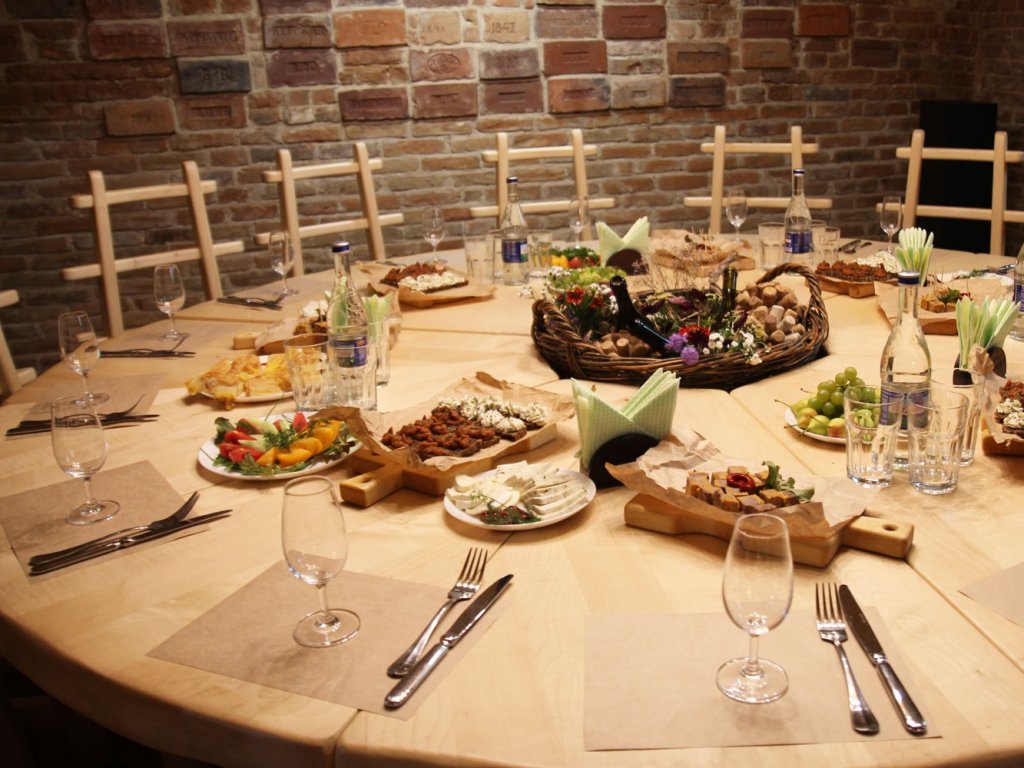

EVGENY RUDENKO
Updated: October 16 2019 at 10:55 amSource: https://www.pravda.com.ua
Areas between the Dniester and the Danube Rivers, the Black Sea and the Yalpug Lake the largest lake in Ukraine. The balance of the sun, winds and moisture, unique soil and many sunny days per year. Rare climate, rich history, a mixture of cultures and tastes make Ukrainian Bessarabia an original gastronomic region of Eastern Europe. A pilot project “The Roads of Wine and Taste” with the support of the EU started in Ukraine in the spring of 2019.
Wine-and cheesemakers, Bessarabian farmers, tour operators and restaurateurs are already working over the development of the first Ukrainian gastro-route.
As planned, this route will unite the Bolgrad-Krinichnoye-Izmail-Vilkovo centers. The organizers are considering some other interesting locations in the Odessa region too.
A testing "The Road of Wine and Taste" will be over next two years. The similar routes will be created in other regions of Ukraine in the case of success and combined into the national system of "gastronomic roads".
The project will be interesting not only for foreign tourists who are attracted to East European exotic, but for Ukrainians, who do not suspect what discoveries for gourmets Odessa region holds.
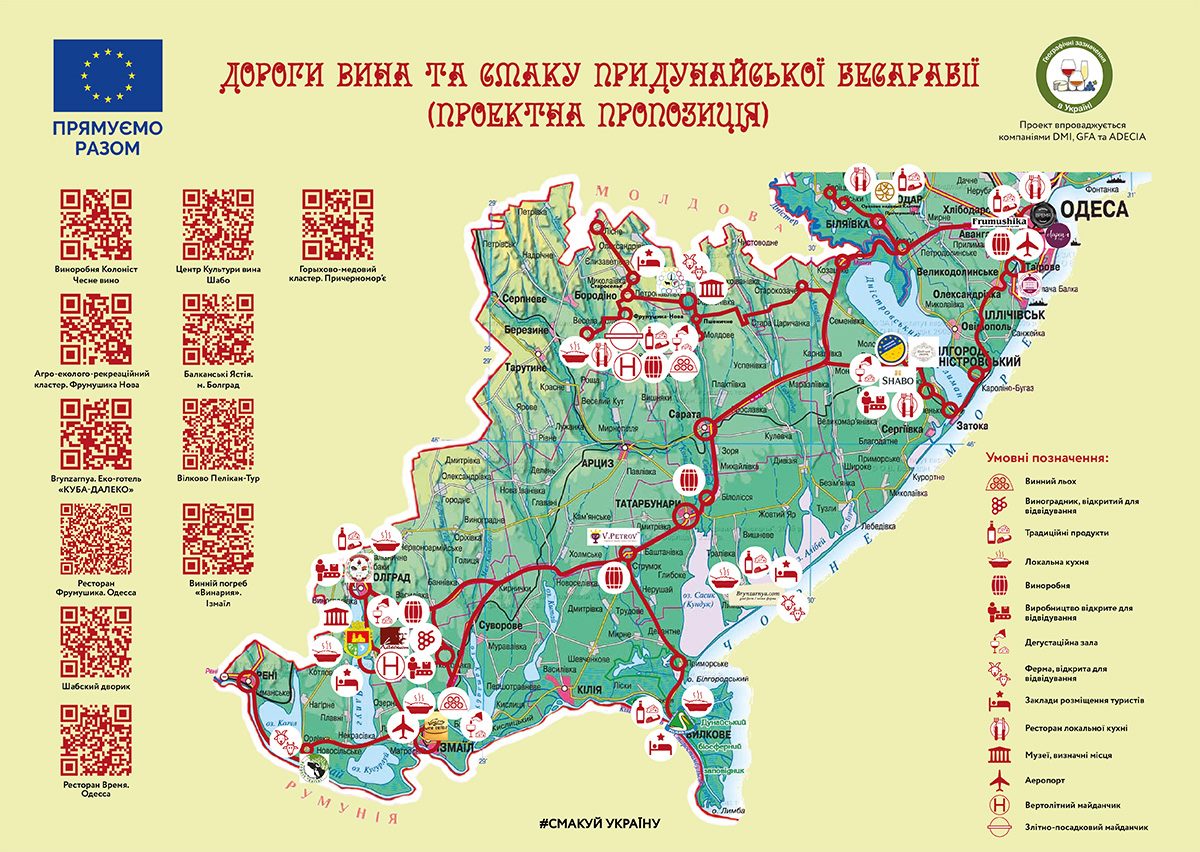
- A lot of oak, good tannins, great maturing potential in a bottle. The correct acidity and full-bodied, velvety, with tertiary aromas of tobacco and leather: those characteristics of wine can be heard from the professionals not in Italian Piedmont or French Bordeaux, but in the south of Ukraine.
What is Bessarabian ricotta? How does lamb get rid of a nasty smell? What’s the differece between sujuk and sushenitsa and what kind of spice are Bulgarians called Chanel№5? You can read it in the article.
Shabo. The Swiss Mark and Wine Latitude
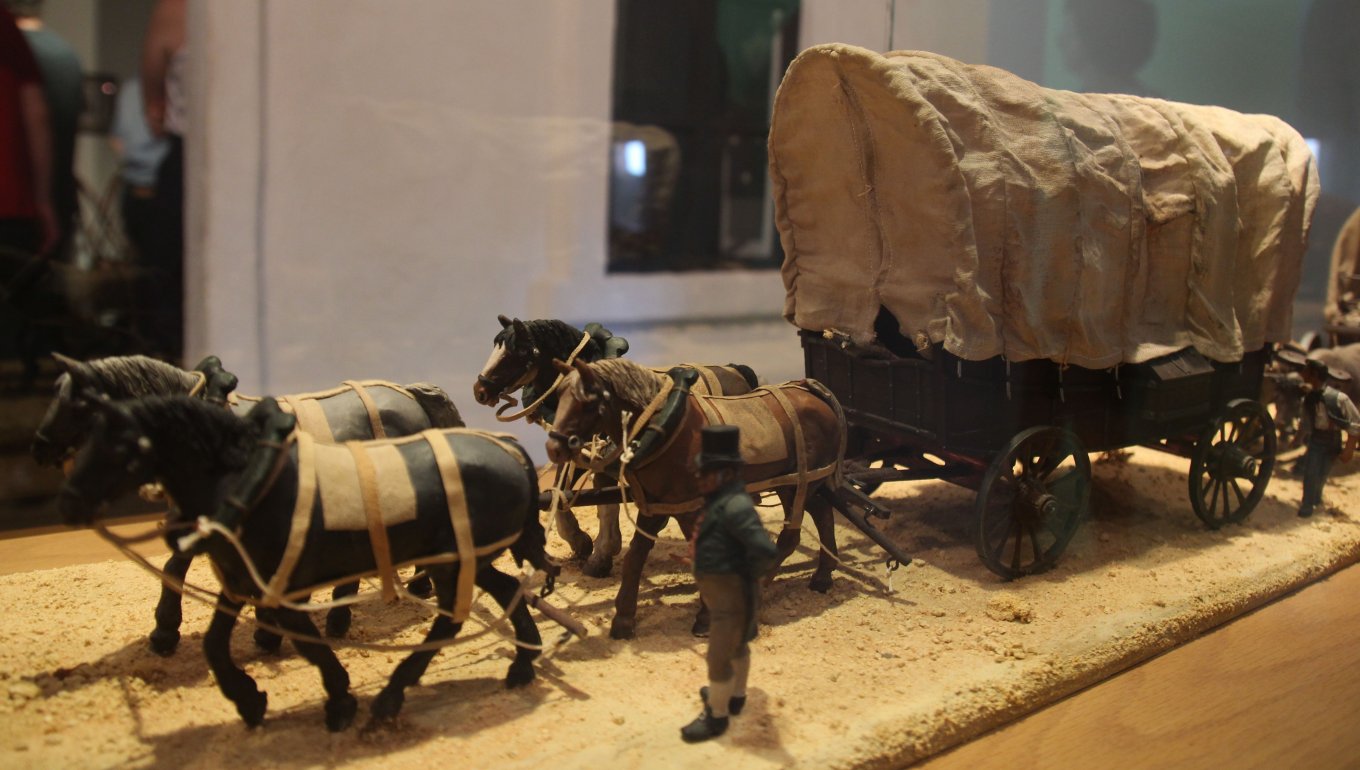
The passionate from the town of Vevey, the canton of Vaud, took the family, the Bible, provisions, a carbine and his rich knowledge in viticulture only.
Thus began the history of the Swiss colony of Shabo, which became one of the largest centers of Ukrainian winemaking two hundred years later.
It was not by chance that Louis Vincent Tardan chose this place on the shore of a distant estuary on the periphery of Europe.
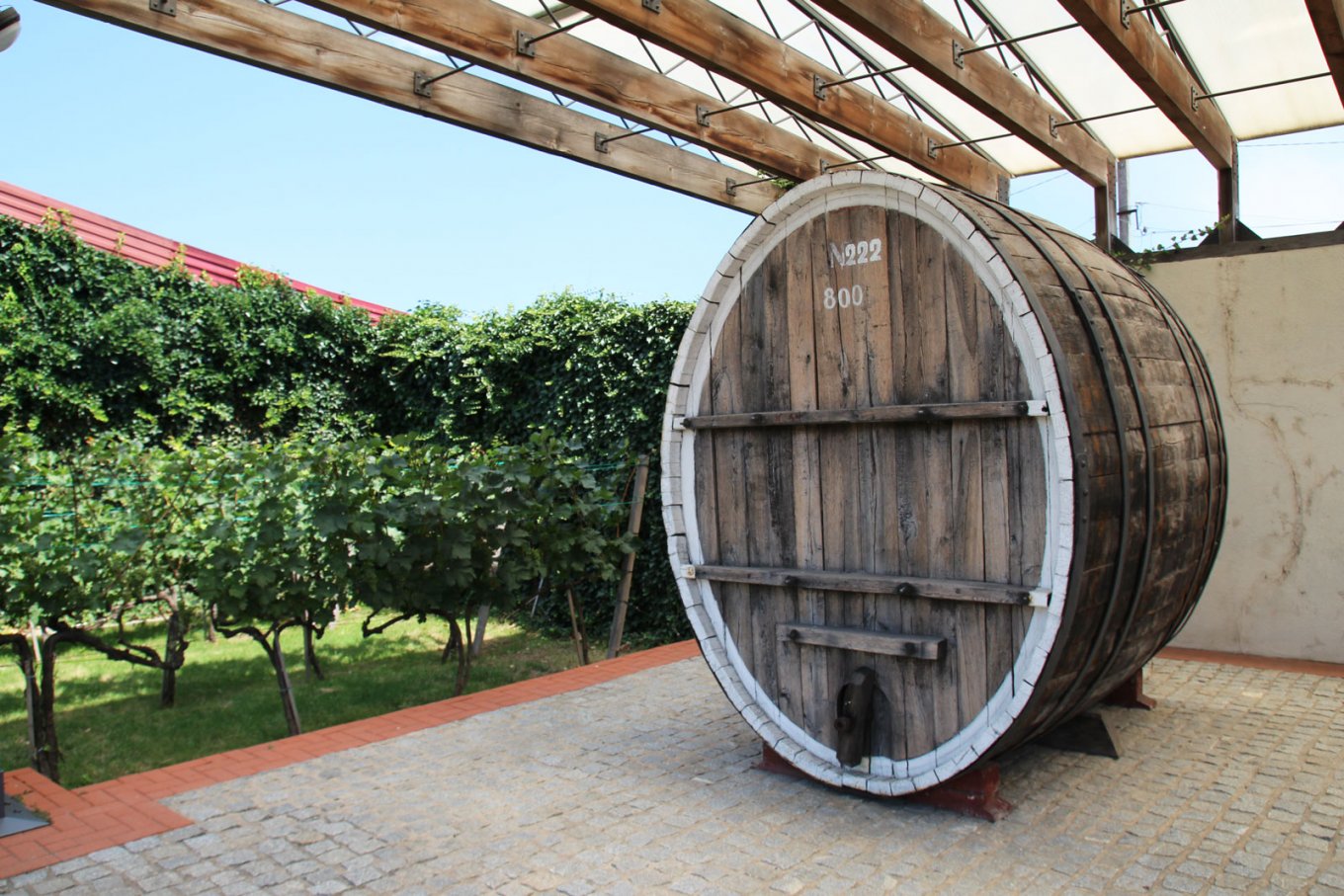
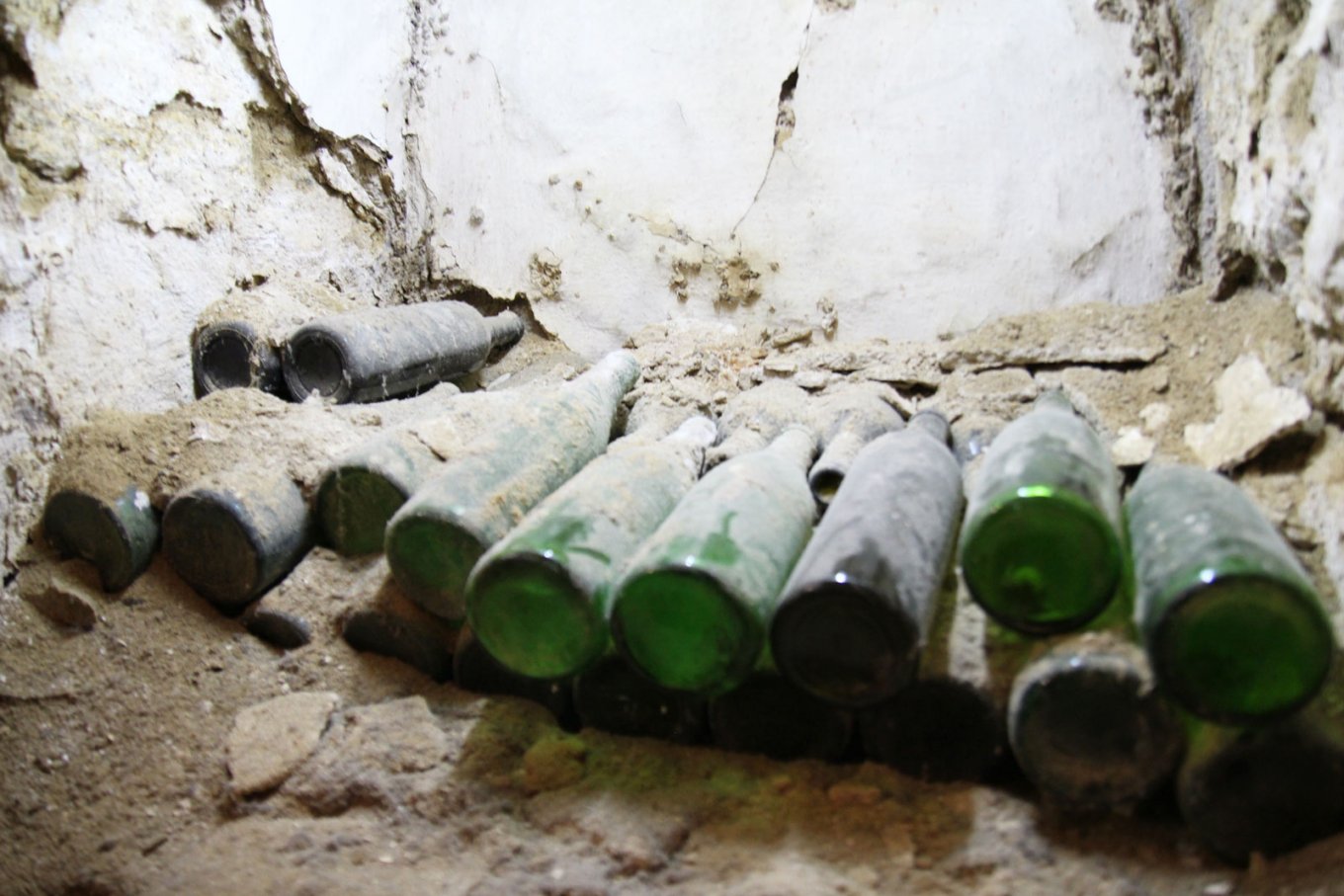
Those who know the viticulture can talk for a long time about the specifics of the local climate. Simply put, it is a mix of chernozem and sand, plenty of sun and strong changes day and night temperature, that gives the desired balance of sugar and acidity.
A "Wine latitude" is a term from the vocabulary of winemakers calling the best lands for their work. They enter the belt from 30 to 50 parallel in the northern hemisphere of the planet. Bessarabian winemakers were lucky to be born on the 46th.
Today in the Odessa region up to 19 thousand hectares of vineyards. According to Yulia Bulayeva, scientific secretary of the National Scientific Center "The V. E. Tairov Institute of Viticulture", 20 years ago there were here twice as many. But current figures also make this region a leader in Ukrainian winemaking.
“After the occupation of Crimea, we have about 40-42 thousand hectares in the country,” she says. – There is Kherson, Nikolaev, part of Zaporozhye region and Zakarpatye.
I would call a feature of Odessa vineyards is a high percentage of varieties of native Ukrainian selection about 14%.
And speaking of European or global scale, we are talking about unique products that you will not find anywhere else.
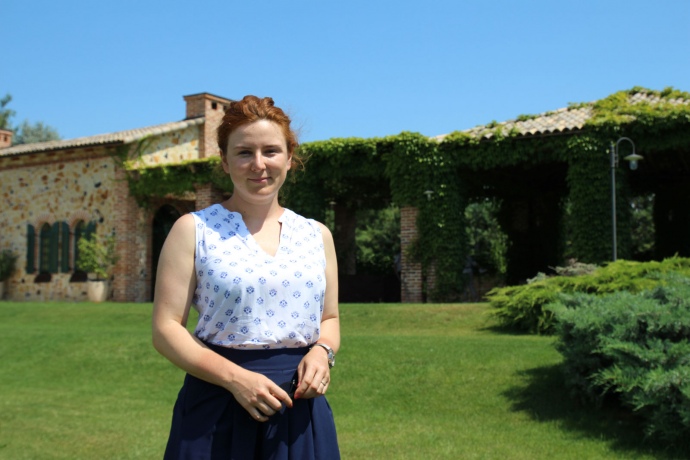
Yulia Bulayeva states that domestic producers hard to compete with imported products. One of the reasons is our consumer does not know Ukrainian wine well and they sure that imported wine is necessarily better, albeit cheaper.
“The minimum price of natural wine without additives is from 100 hryvnias,” says Yulia Bulayeva. – But it largely depends on the capacity of the manufacturer. And the bigger they are, the lower the cost.
It is difficult for small wineries to compete because there are no automated processes. This is a handicraft.
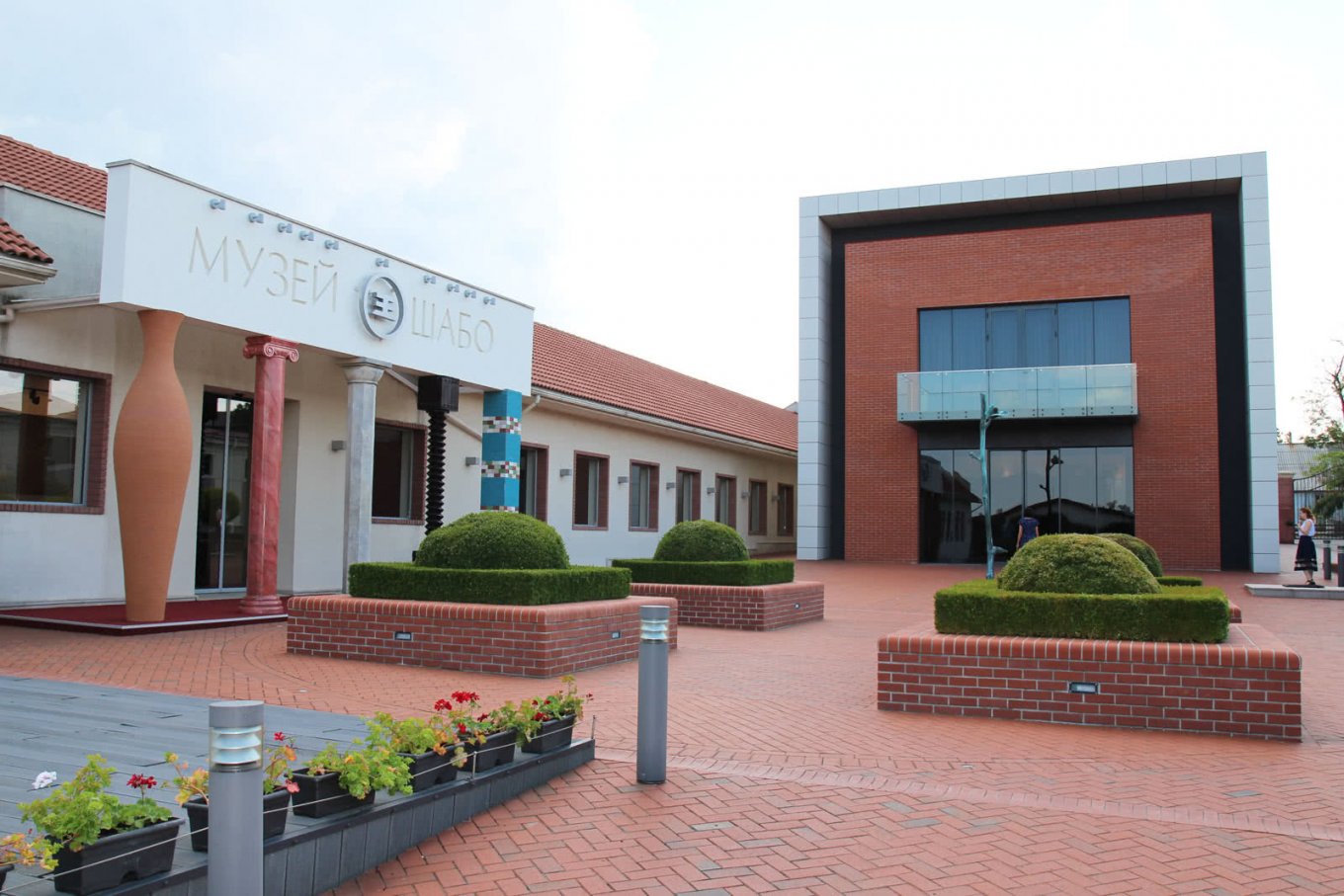
The village of Shabo with the company of the same name, a museum and "The Wine Culture Center" may become one of the points of the future gastro-route in the Odessa region.
Descendants of Swiss colonists work with grape varieties like Cabernet Sauvignon, Merlot, Pinot Noir, Saperavi, Chardonnay, Sauvignon Blanc, Riesling Rhine, Muscat Ottonel, Telti Kuruk, Rkatsiteli.
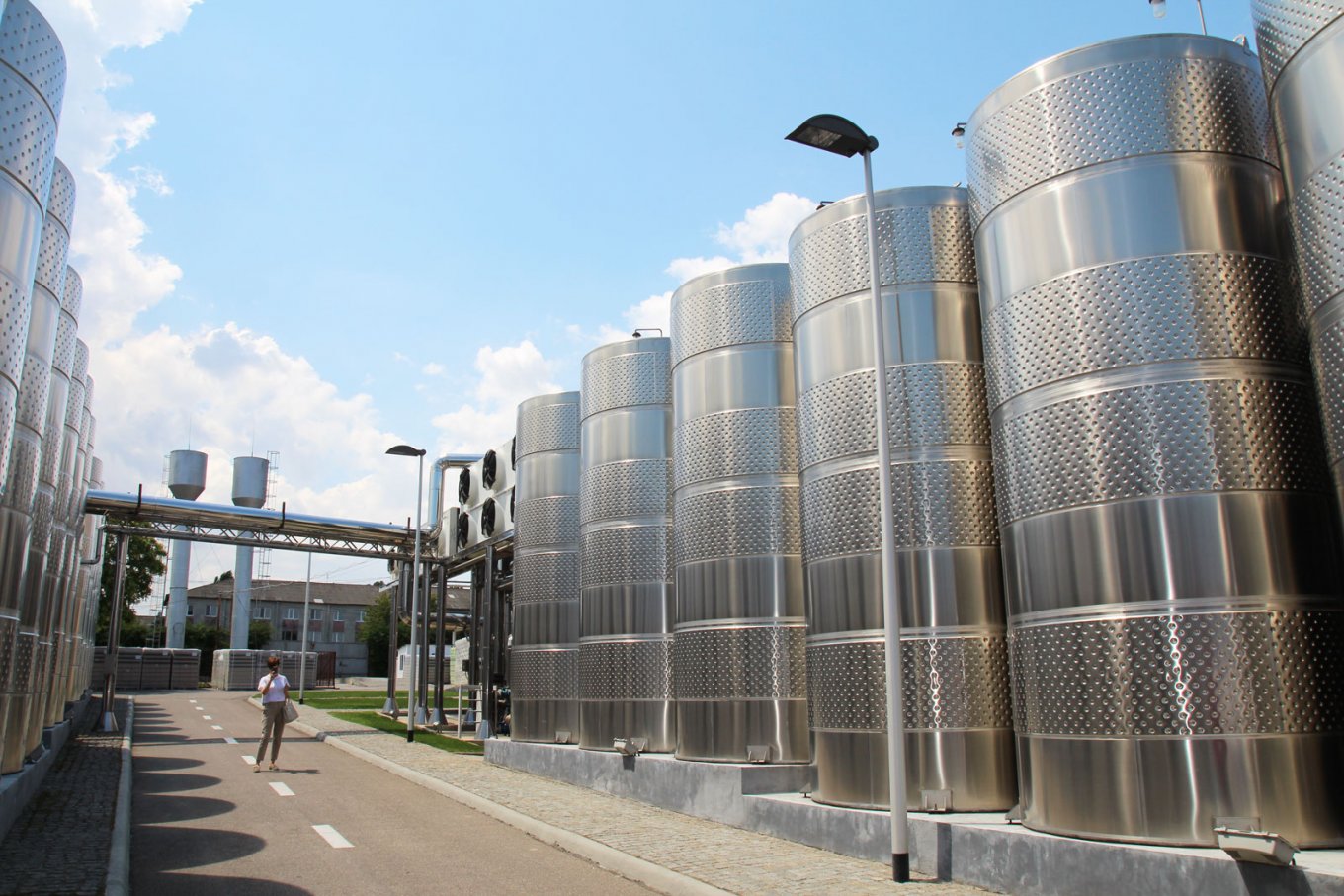
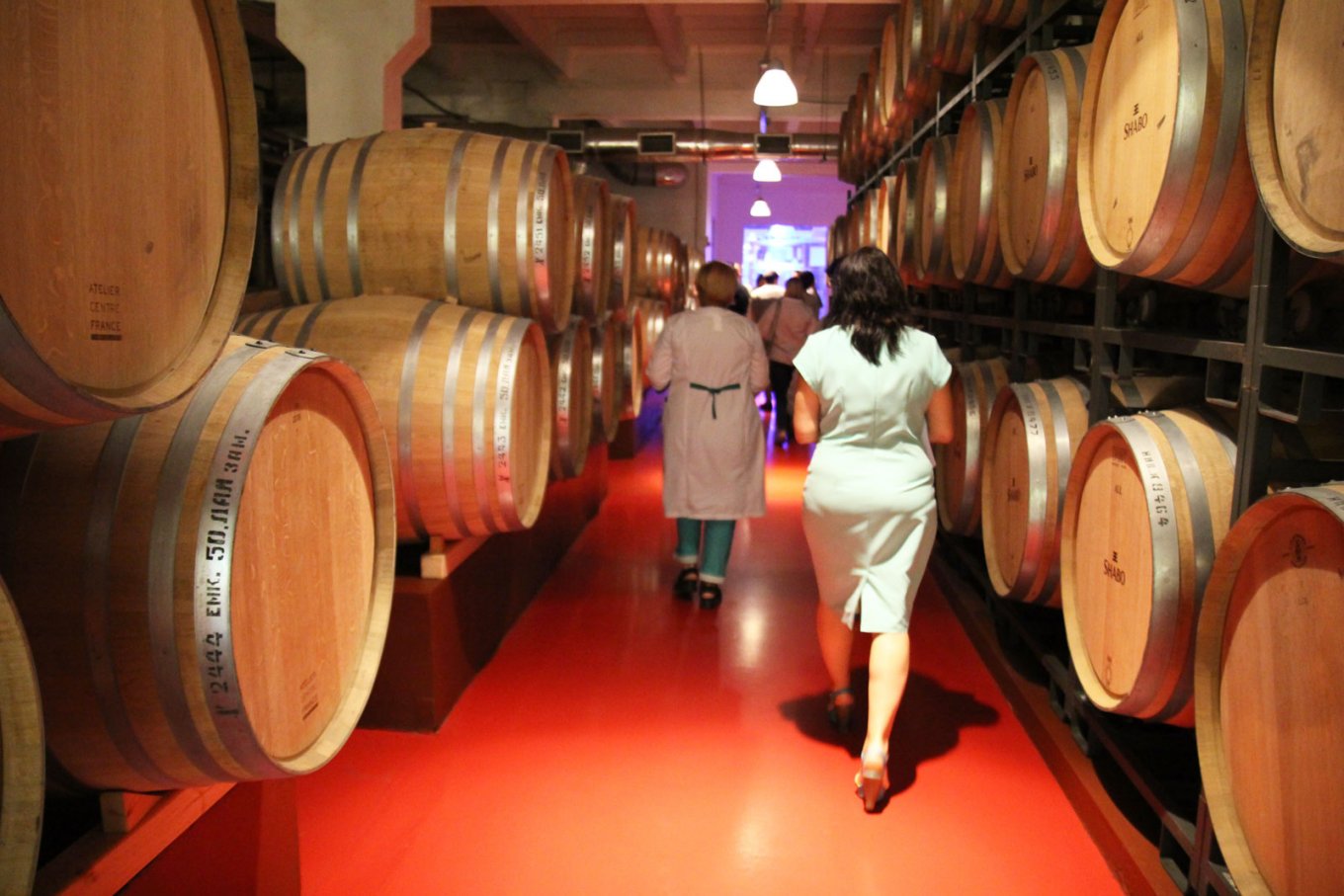
Today, Shabo it is mass production with the modern equipment in which tens of millions of euros have been invested. About 12 thousand tons of grapes are processed here in the season.
The local winery occupies about 10 thousand square meters and go underground for nine meters.
In total, two thousand oak French barriques are barrels for aging wine are located on the territory of Shabo.
Frumushika Nova. Bryndza and the Call of the Ancestors
Belgorod-Dniester is located on the banks of the estuary just above the former colony, Shabo.
Here, in the ancient Akkerman fortress, will be poured wine and prepared a “medieval meal” with lentils, rabbit and quail baked on a fire, quails and kvass also for you.
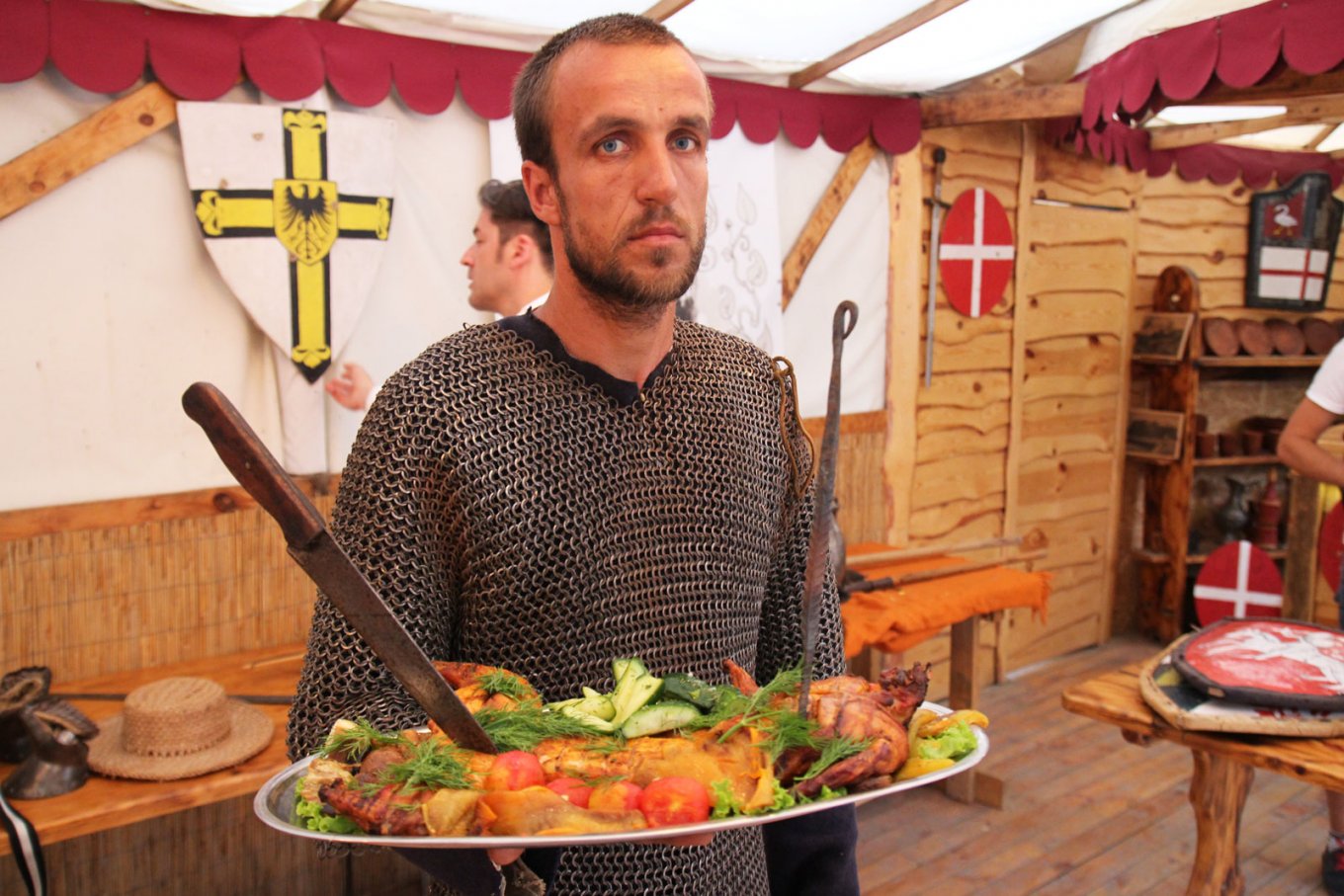
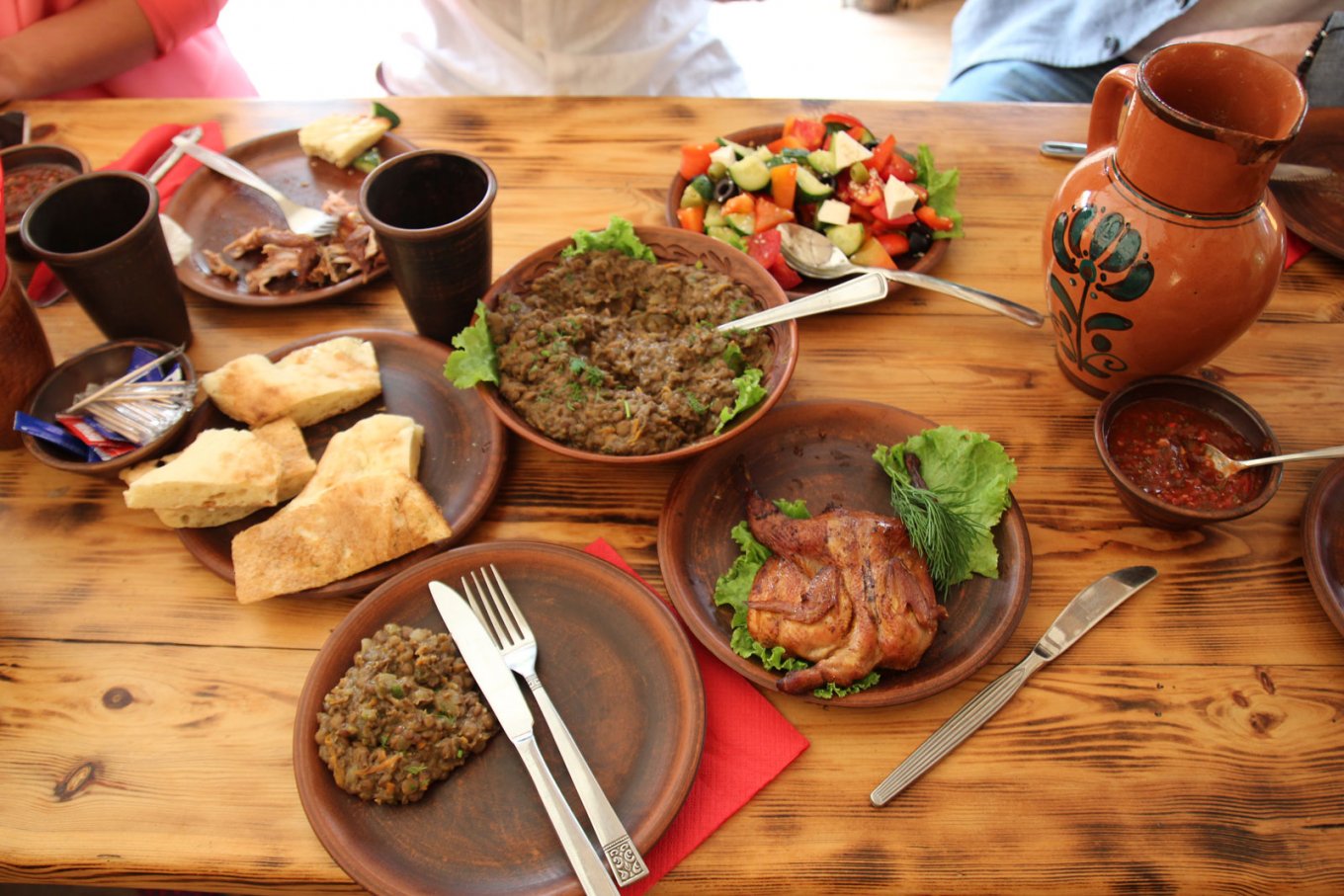
However, you need to go to Frumushika Nova in order to really get hungry and appreciate with an appetite the Bessarabian culinary exoticism.
A wind and shepherds with sheep walked in the Tarutino steppe, 10 kilometers from the border with Moldova, just 15 years ago. So far, Odessa businessman Nikolai Palariev has not built a center of ethnographic and green tourism. He invests millions in the development of the center.
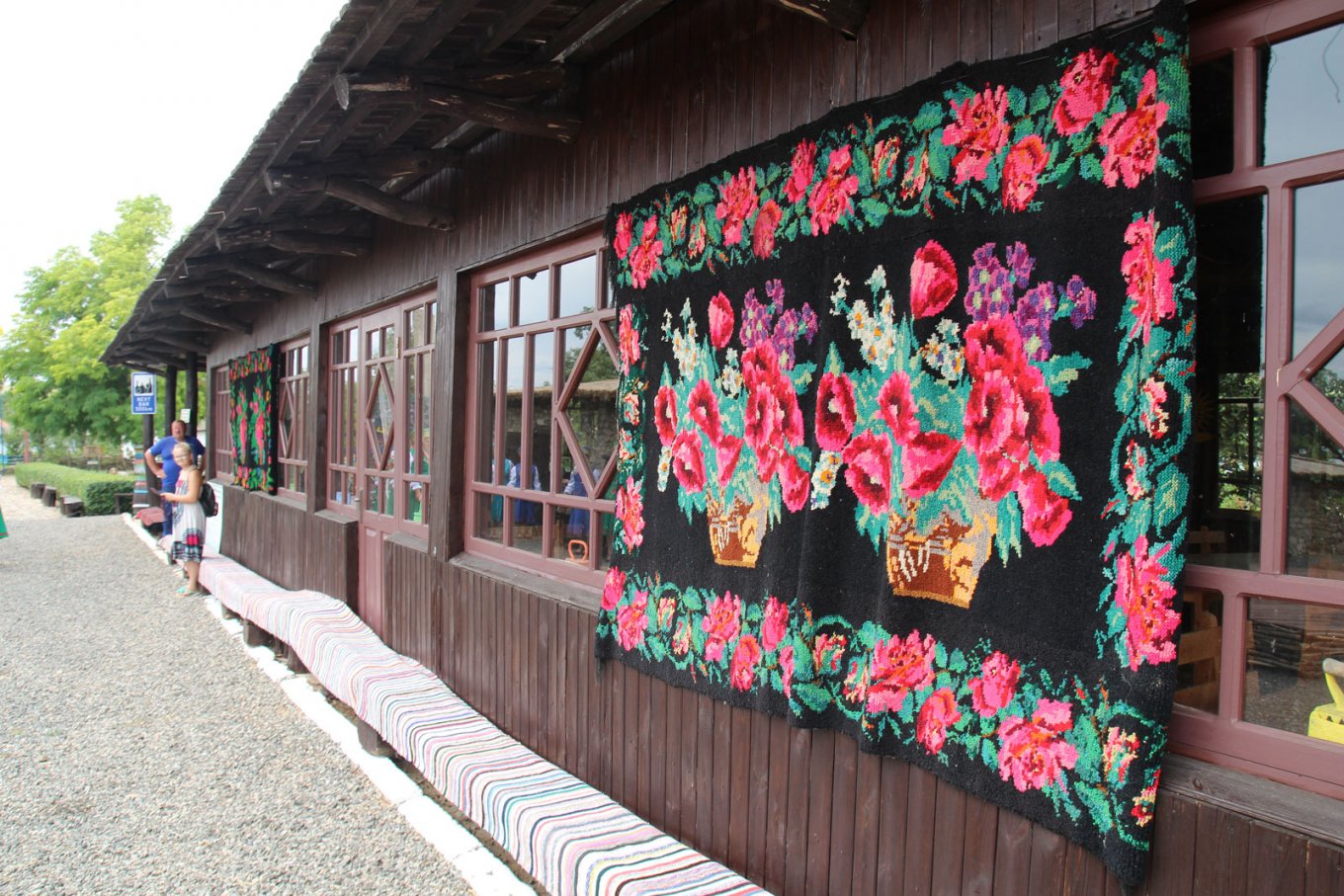
In fact, Palariev restored the village of his ancestors, which was destroyed by the Soviet government in the late 40s of the last centuries in order to arrange a military training ground on these lands.
The ancestors of Palariev, like many in Bessarabia, were from Moldova.
He remembers cuisine where were mixed not only Moldavian, but also Bulgarian and Turkish tastes from childhood.
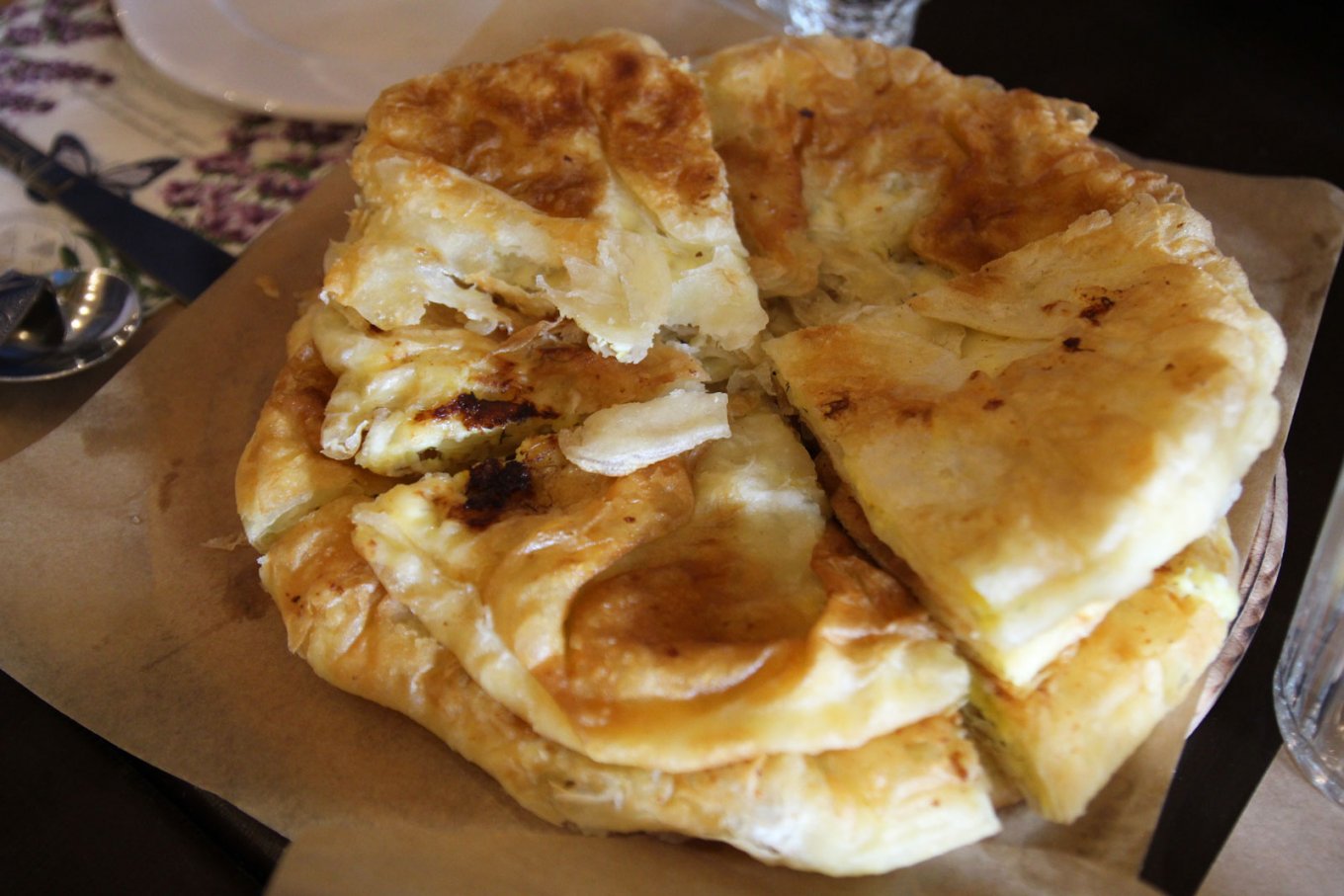
“Bulgarians call a similar dish a milina, and here it’s a placinta,” says the businessman, treating his guests. - Here it is with cottage cheese and dill.
In general, the ingredients are the same. But the cooking method may differ. Each mistress has different nuances, which are inherited from great-grandmothers, grandmothers and mothers.
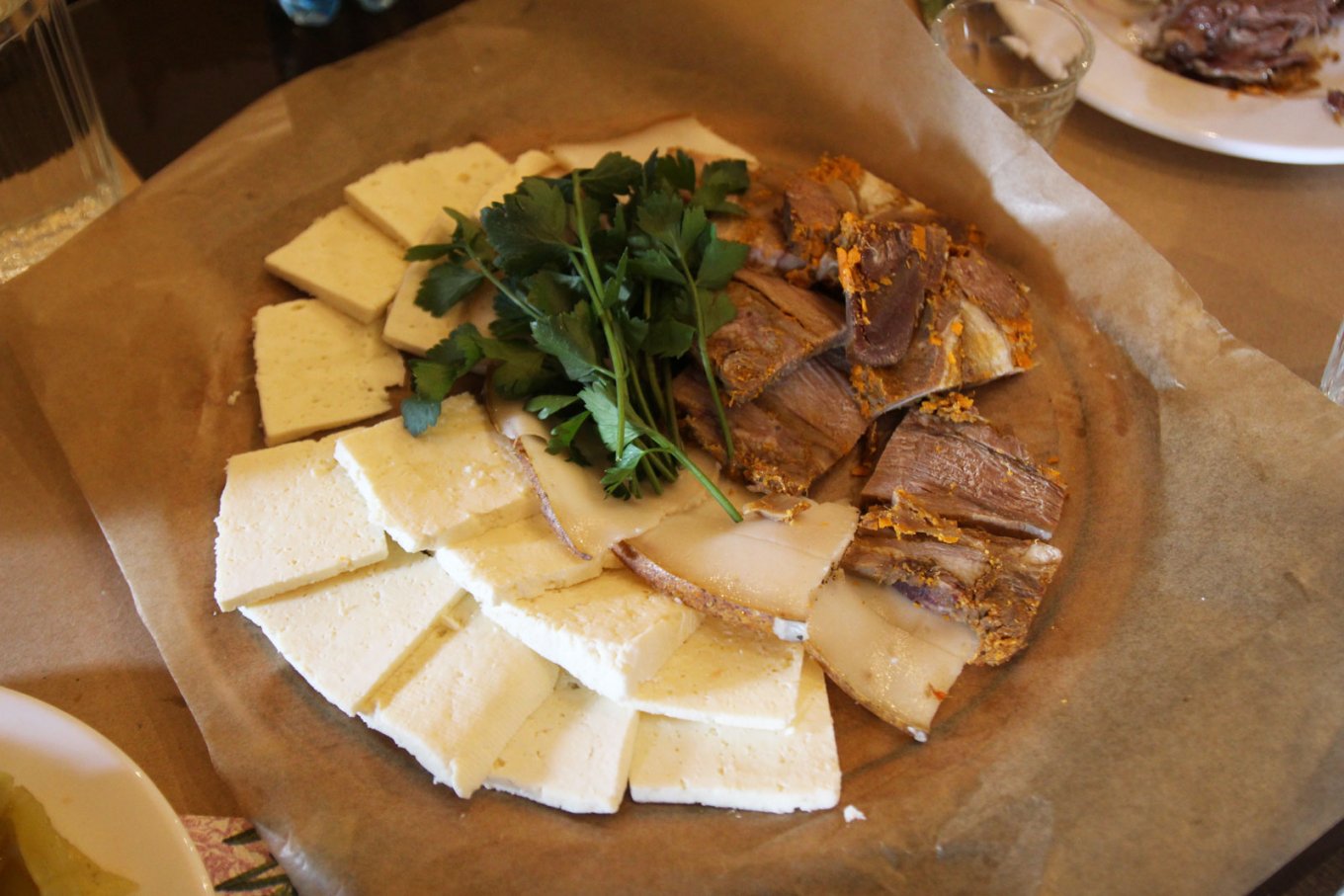
Most Bessarabia products are associated with lamb partially or fully. Historically, sheep are the base animal in this territory.
Frumushika Nova of Nikolai Palariev began with the built the largest farm of Karakul sheep in Europe in the steppe. Therefore, there is no shortage of cheese and meat dishes.
Such as baked lamb, for example. Mititei it is Moldavian mincemeat sausages, like meatballs, or Bulgarian cold kavarma it is a frozen boiled lamb in yellow-orange fat.
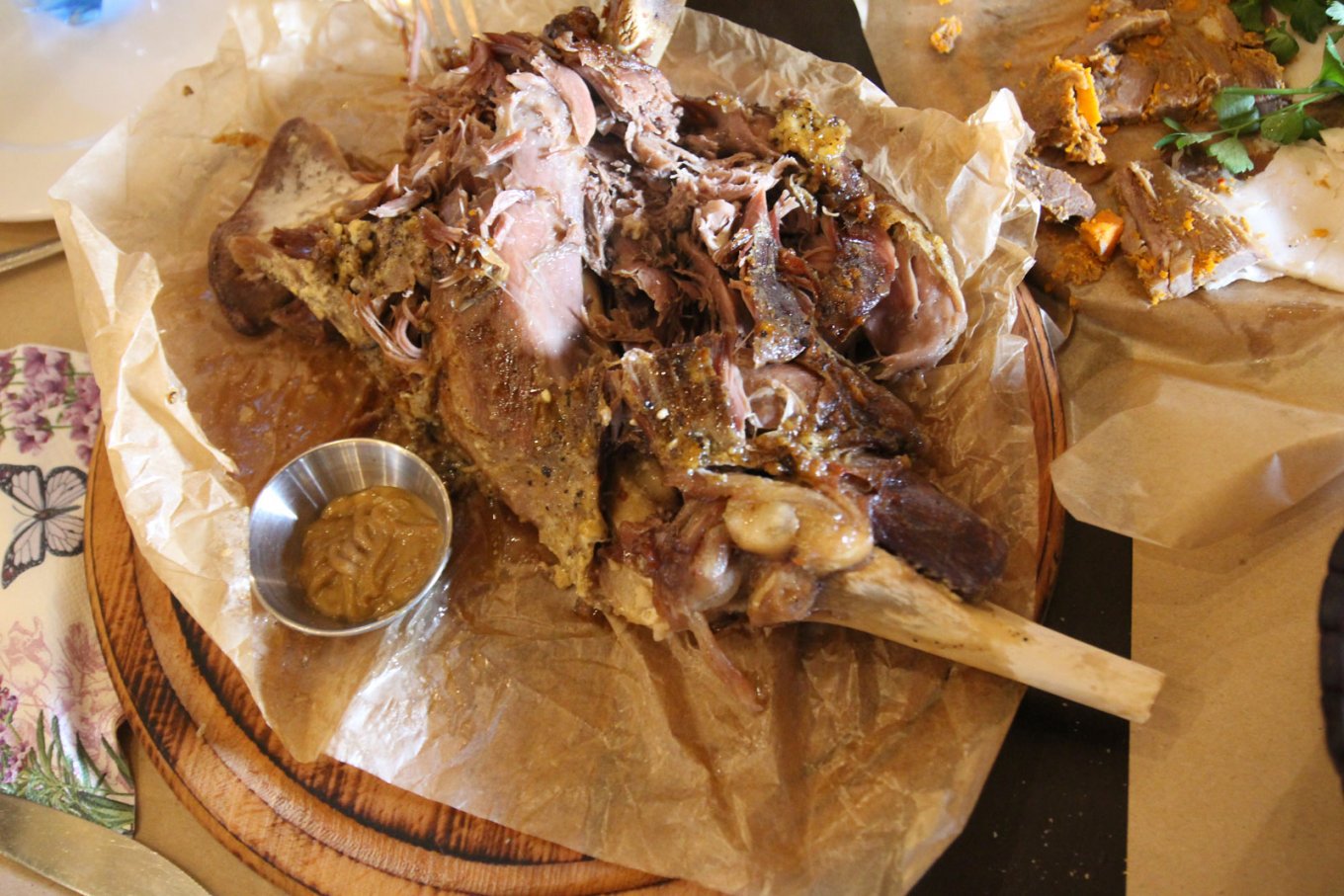
Zama is popular among the first dishes. It is an invigorating, warming noodle chicken soup with bran kvass.
Frumushika Nova remains one of the most unknown tourist sites in Ukraine during 13 years after its founding.
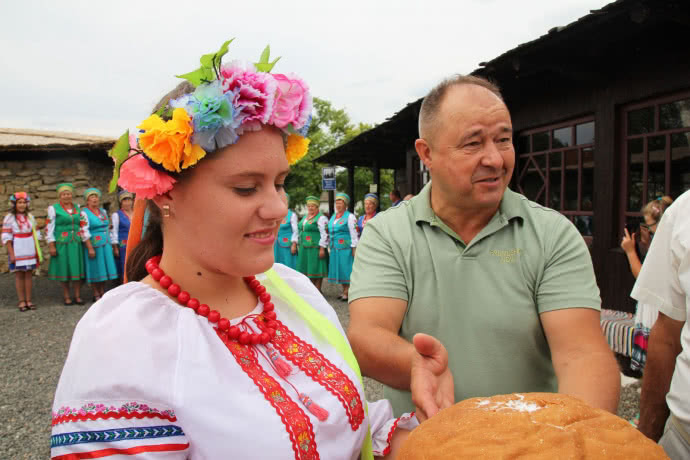
The journey from Odessa to Frumushika about 200 kilometers long and takes more than three hours. The final 15-kilometer stretch runs simply through the fields and off-road. Therefore, you need to consider the weather forecast before traveling, see to the connection and take the spare.
Izmail. Share of the Angel and Lipovans
Another valuable point on the gastronomic map of Odessa region is Izmail. It’s one of the largest seaports on the Danube with population of 70,000 persons and one of the most underrated tourist cities in Ukraine.
As a non-official capital of southern Bessarabia Izmail absorbed various traditions.
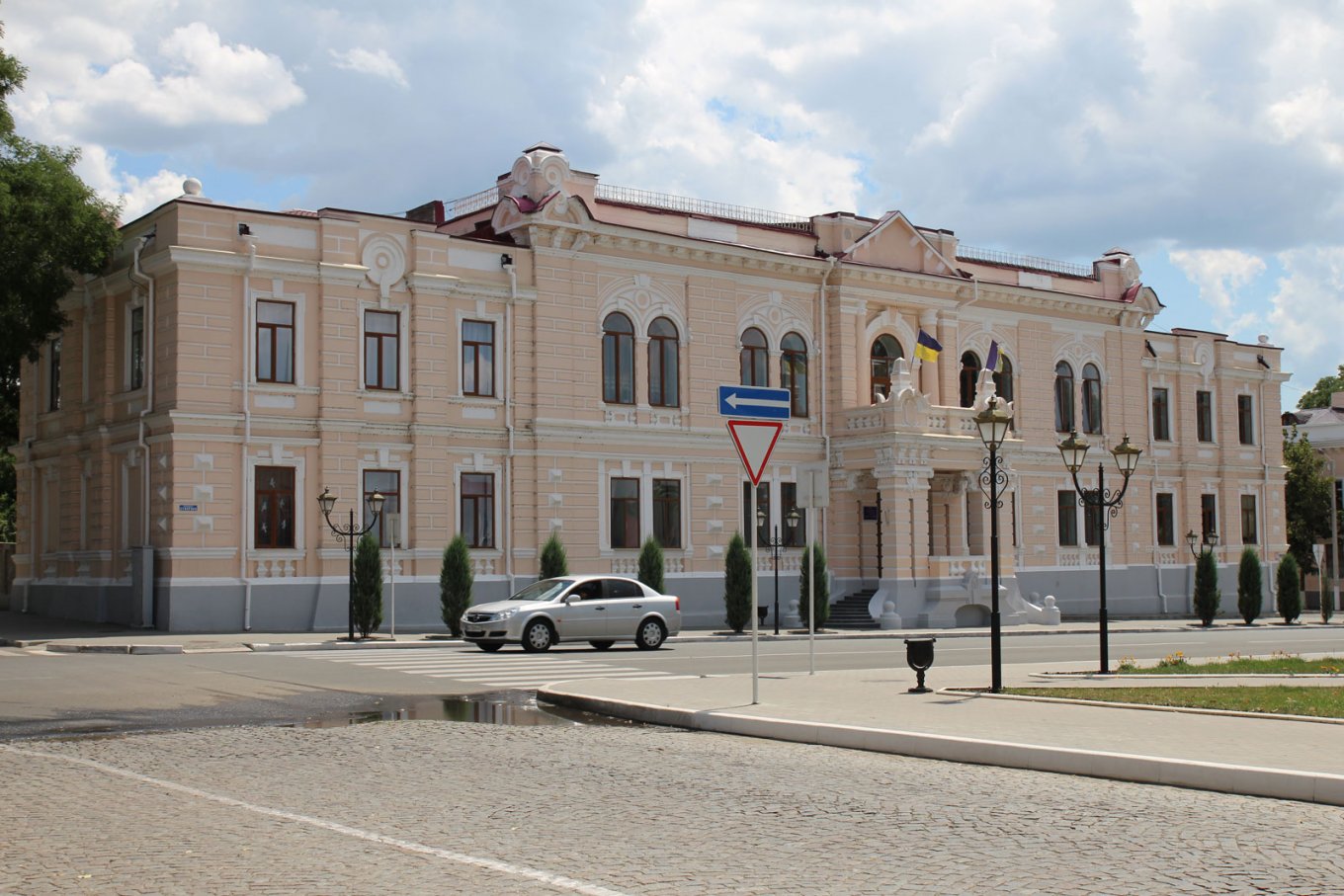
A wine cellar was hidden in the basement of an inconspicuous two-story house near the local market. It was opened by Irina Polshakova a native of Izmail.
Under an arch of bicentennial bricks she tells a legend about Sergey Tuchkov. He allegedly lived above these basements in the early 19th century. However, the legend not supported by historical documents.
Sergey Tuchkov was lieutenant-General, Senator and Freemason. He became the first mayor of Izmail which conquered by the Russian Empire from the Turks.
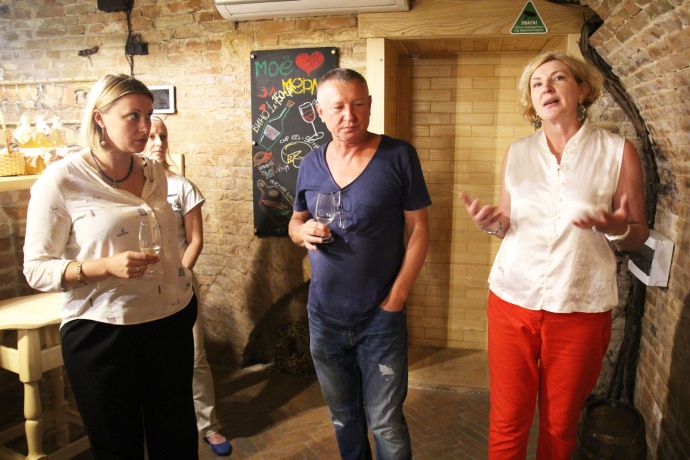
Today in the cellar of Polshakova a tart smell of oak and wine of their own production.
Guests are invited to pour into glasses from barrels by tradition, and then pour the remnants of wine directly onto the floor.
- Someone calls this smell "the share of the angel." The brick is impregnated, and now you feel the spirit, the aroma inherent in Bessarabian cellars,” says Irina.
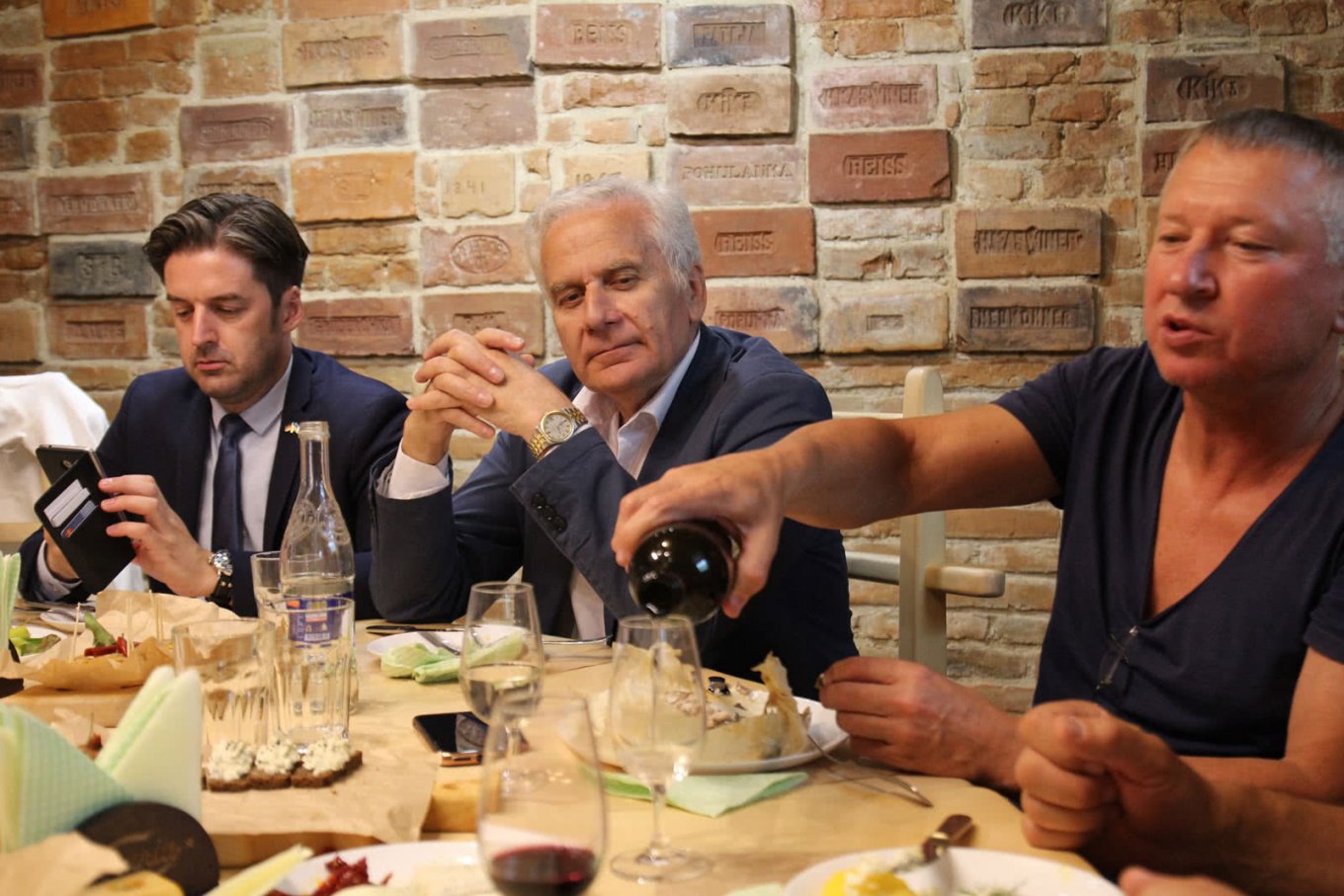
A highlight of the home winery is dry white wine based on wormwood, which is picked in certain places of Bessarabia.
The Polshakova`s family produces a thousand bottles of this drink in a year. European experts who have been here compare it with vermouth and assess this wine as a “premium product”.
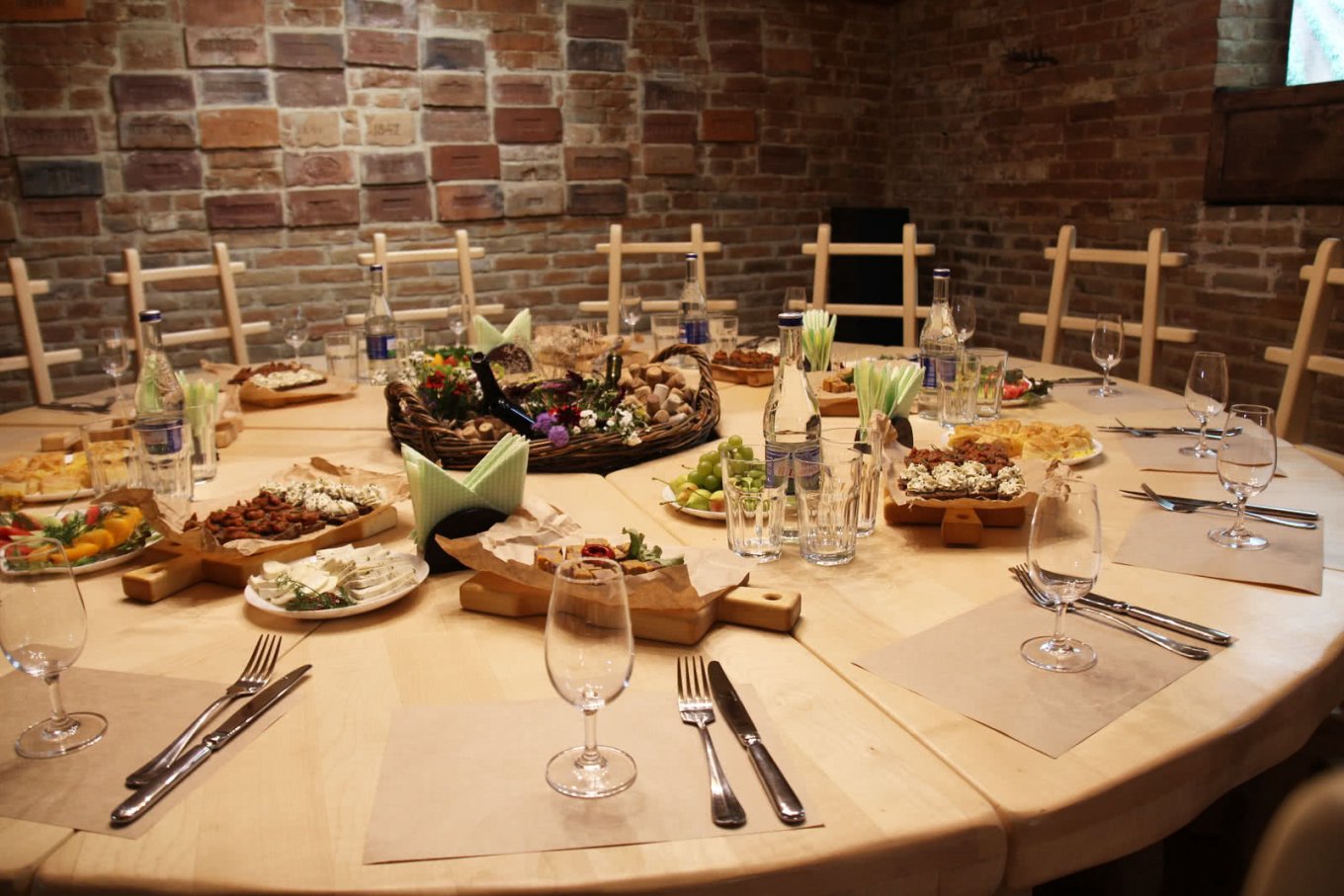
The ancestors of Irina Polshakova are Lipovans, Old Believers who moved to Bessarabia in the 17th century after Nikon's church reforms.
- The most Lipovans were fishing. Therefore, we offer visitors fish dishes, for example, the famous Danube herring.
The baked "Danube" tastier than baked mackerel, the same greasy, but without a pronounced smell.
The "Danube" is prepared in different ways in Izmail: salt, bake. Sometimes herring is frozen, like stroganina with the addition of lemon.
“The most delicious herring is in late March and in April. Then the fish gets specific some unpleasant smell,” says Polshakova.
We try to buy the "Danube" only from fishermen from Vilkovo. There it is the most delicious.
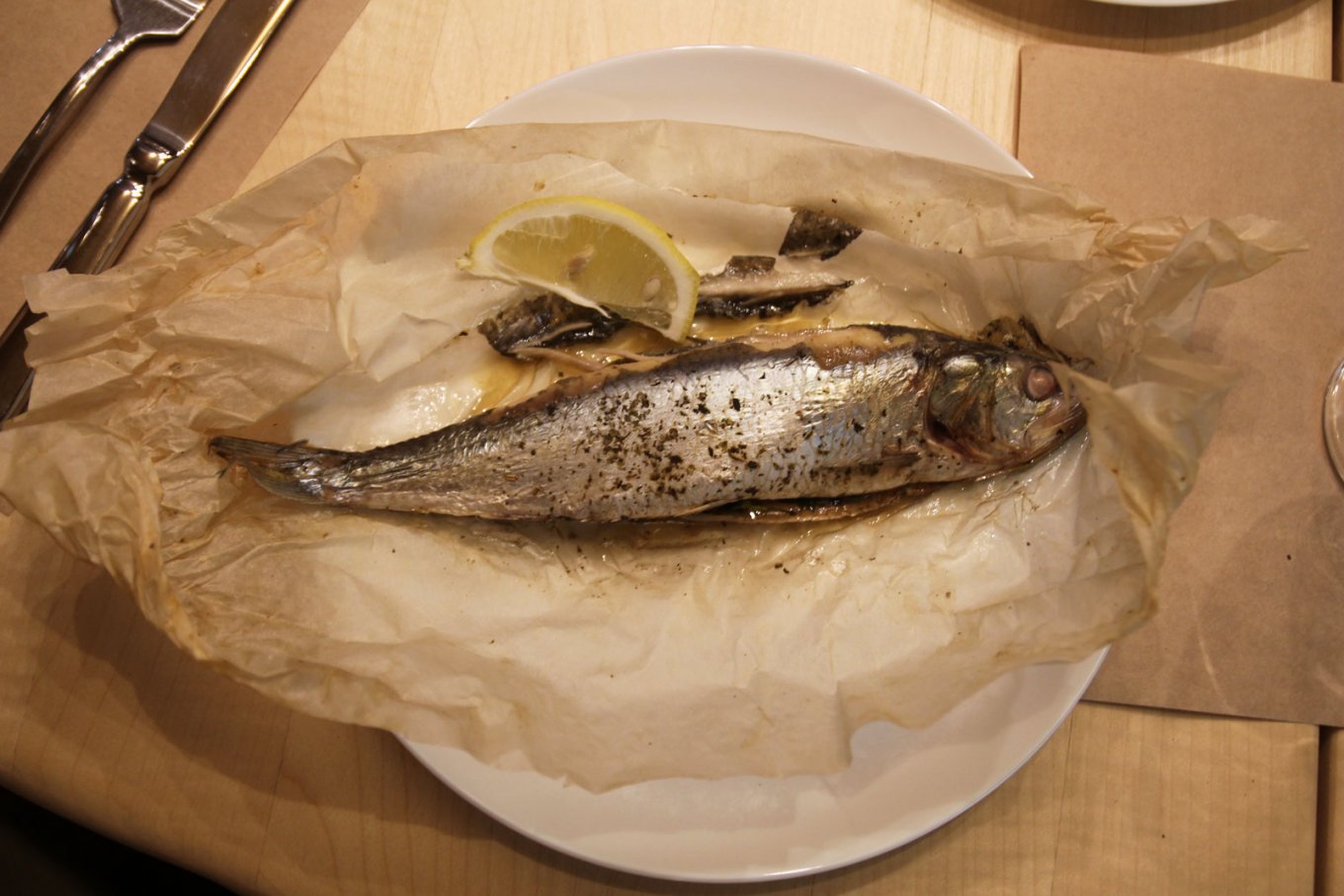
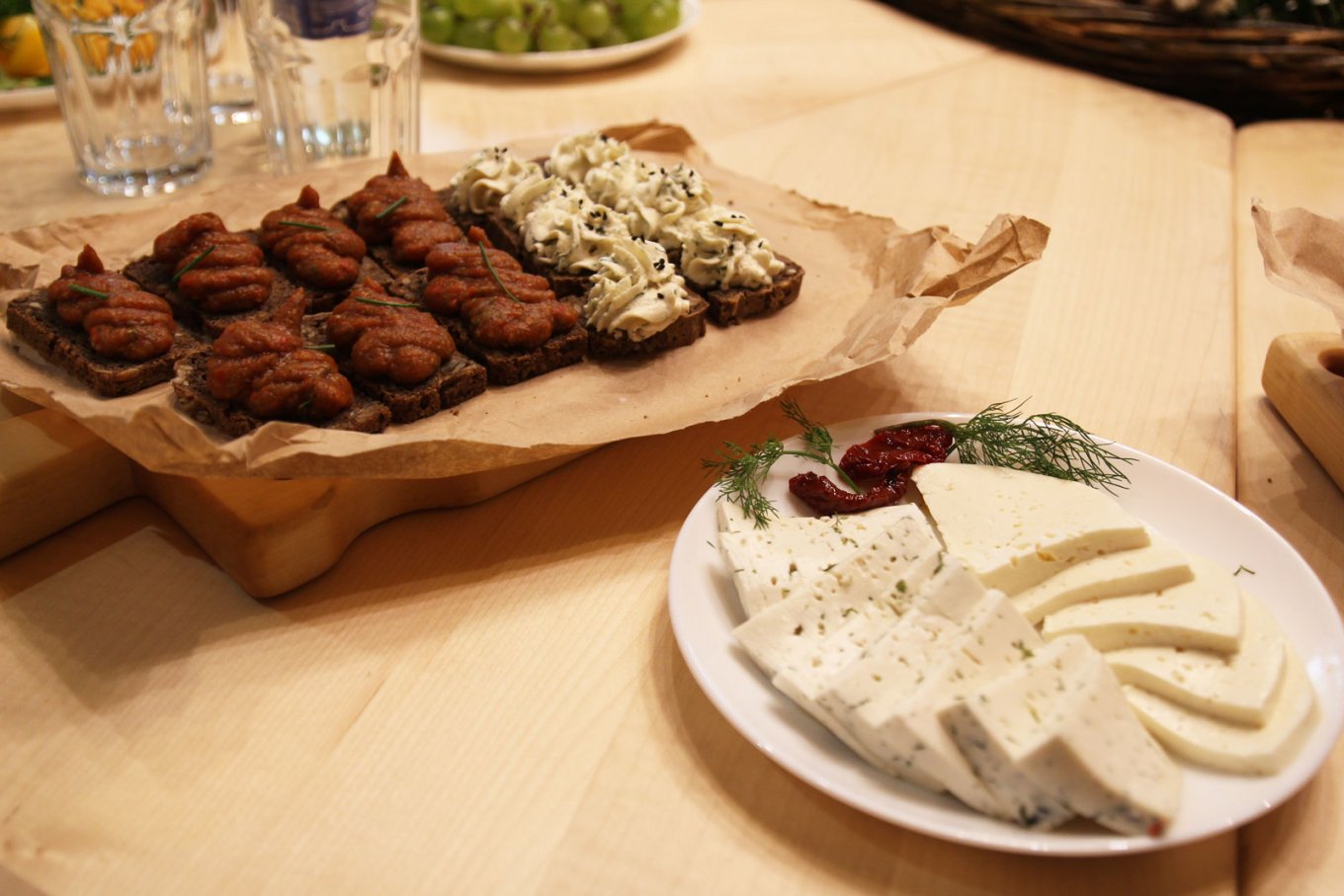
Irina continues, “You can try bread is made with wine yeast, such as it was made by our ancestors Lipovans.”
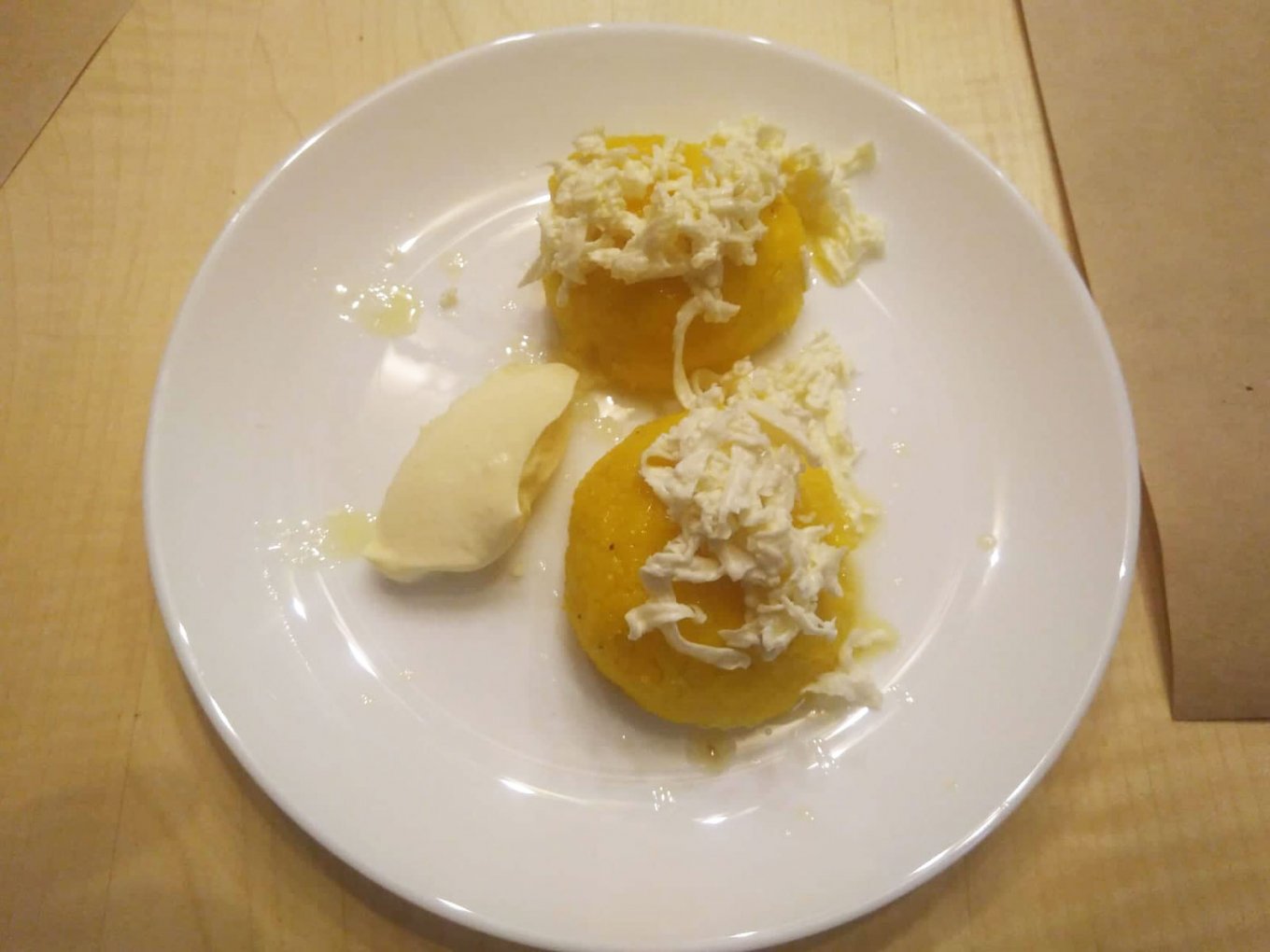
Traditional Bessarabian dishes also serves in Polshakova`s cellar, such as mamaliga or cheese appetizer from sheep’s milk called “urda” it is a local “answer” to Italian ricotta. It is delicious to eat with bread and honey.
Bolgrad. The Kingdom of Spices and Jerky
Bolgrad is located a 40-minute by car from Izmail. The city is known primarily for its winery. However, there is something else surprising here it is the Mehana, which was opened by Sergei Rusev, the local Bulgarian.
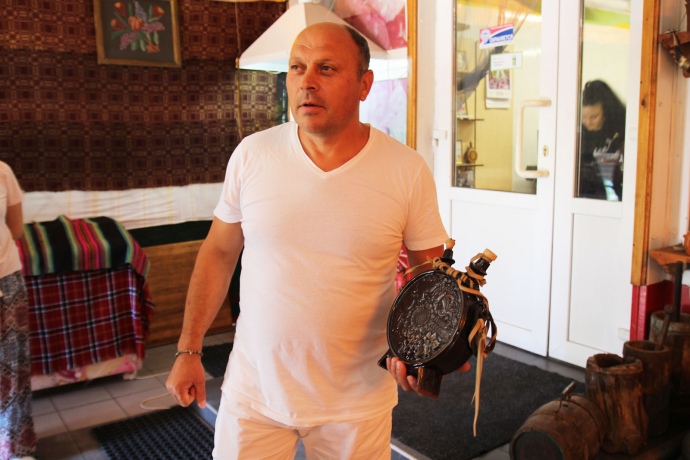
The Mehana it is a traditional Bulgarian restaurant, arranged as a guest yard, where guests are fed with national dishes, such as lamb kurban chorba soup with vegetables or kurban of Dobrudjan is lamb stew with vegetables and herbs.
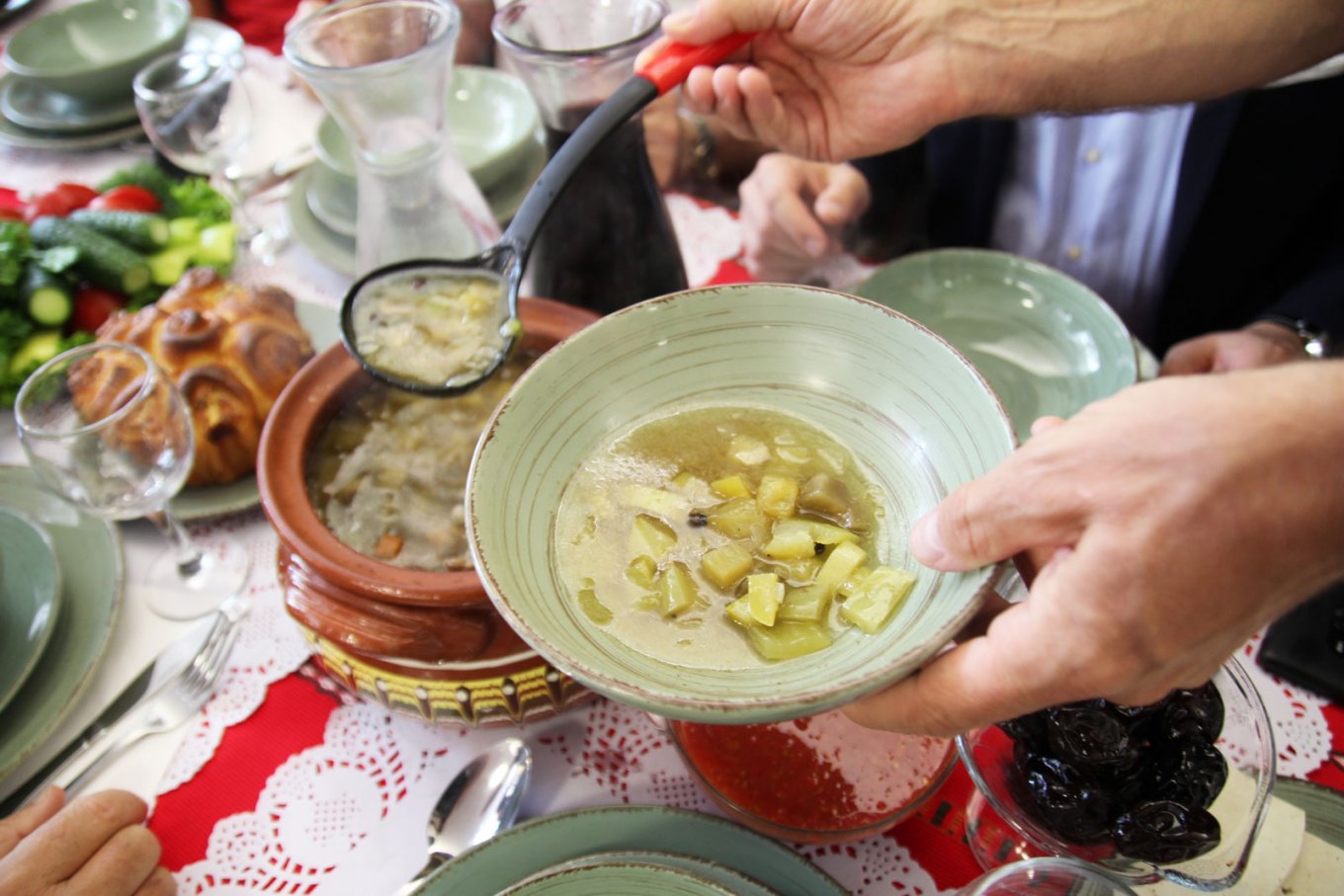
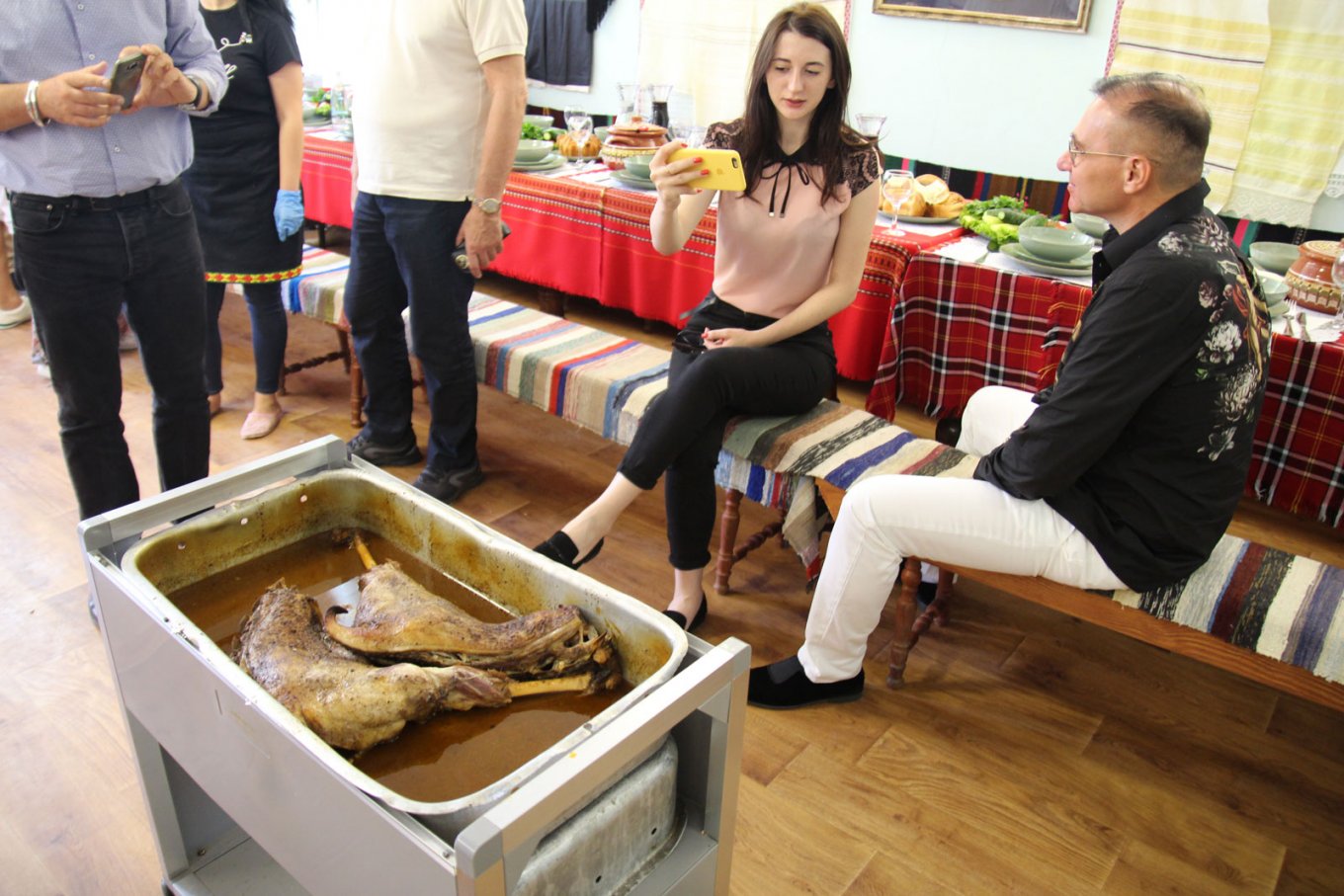
Sergei Rusev can talk about the life and the cuisine of his ancestors for a long time, whetting guests' appetite.
“There is no wine without meat, like meat without wine,” he warns.
Rusev collected ancient household items, including more than 400 wine containers from different villages of the Bolgrad district in a small museum.
“Each bottle has its own purpose. There are daily, there are ritual ones, for when the baby comes or for weddings. There are hiking. There are small for rakia only,” Rusev shows.
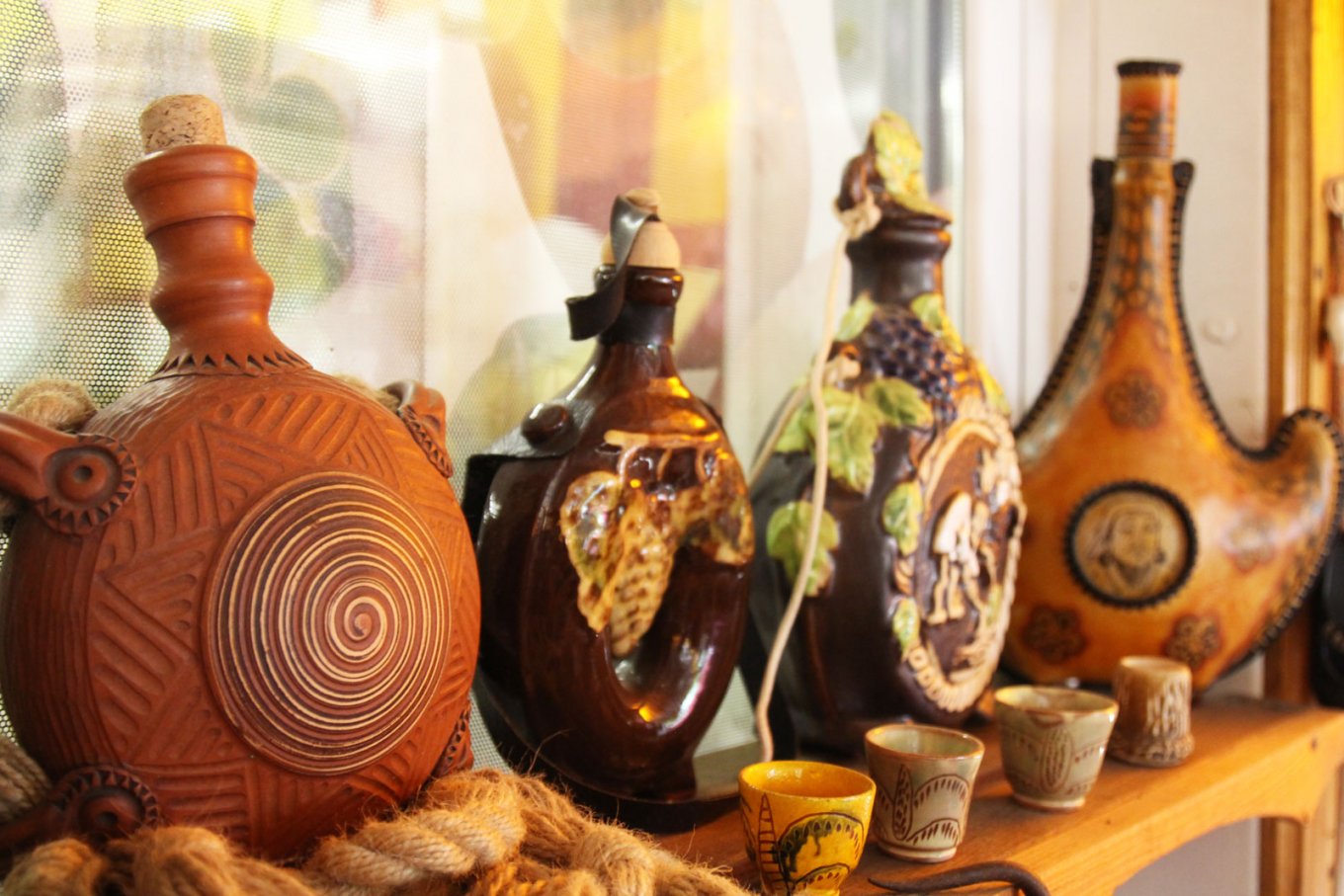
According to Rusev, Bulgarians drink wine sometimes hot with black hot pepper to renew strength and improve digestion.
- People of neighboring villages have differences in clothing, physique, and gait. Where a person comes from, you can even find out by the smell from the mouth because they prefer different spices in different villages, - Sergey explains.
Specialty of Ruseva is production of jerky: sujuk, karnak, basturma, dried cured meat (sushenitsa) and meat chips. There is also adjika, walnut and Bulgarian rose jam.
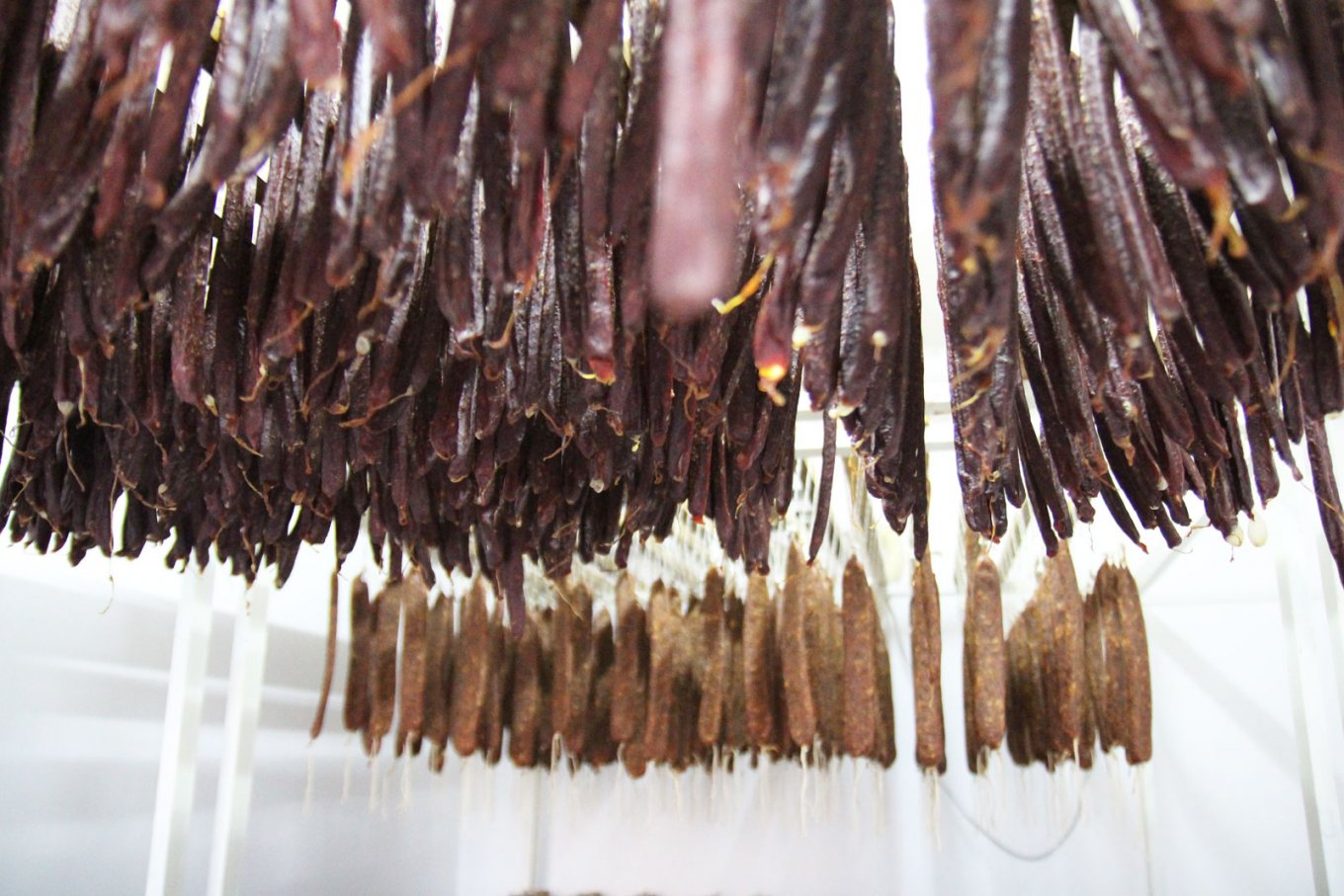
Different types of meat are dry-cured - pork, lamb and beef. About 300 grams come out of a kilogram of fresh meat after "drying" at a certain temperature in a special refrigerator.
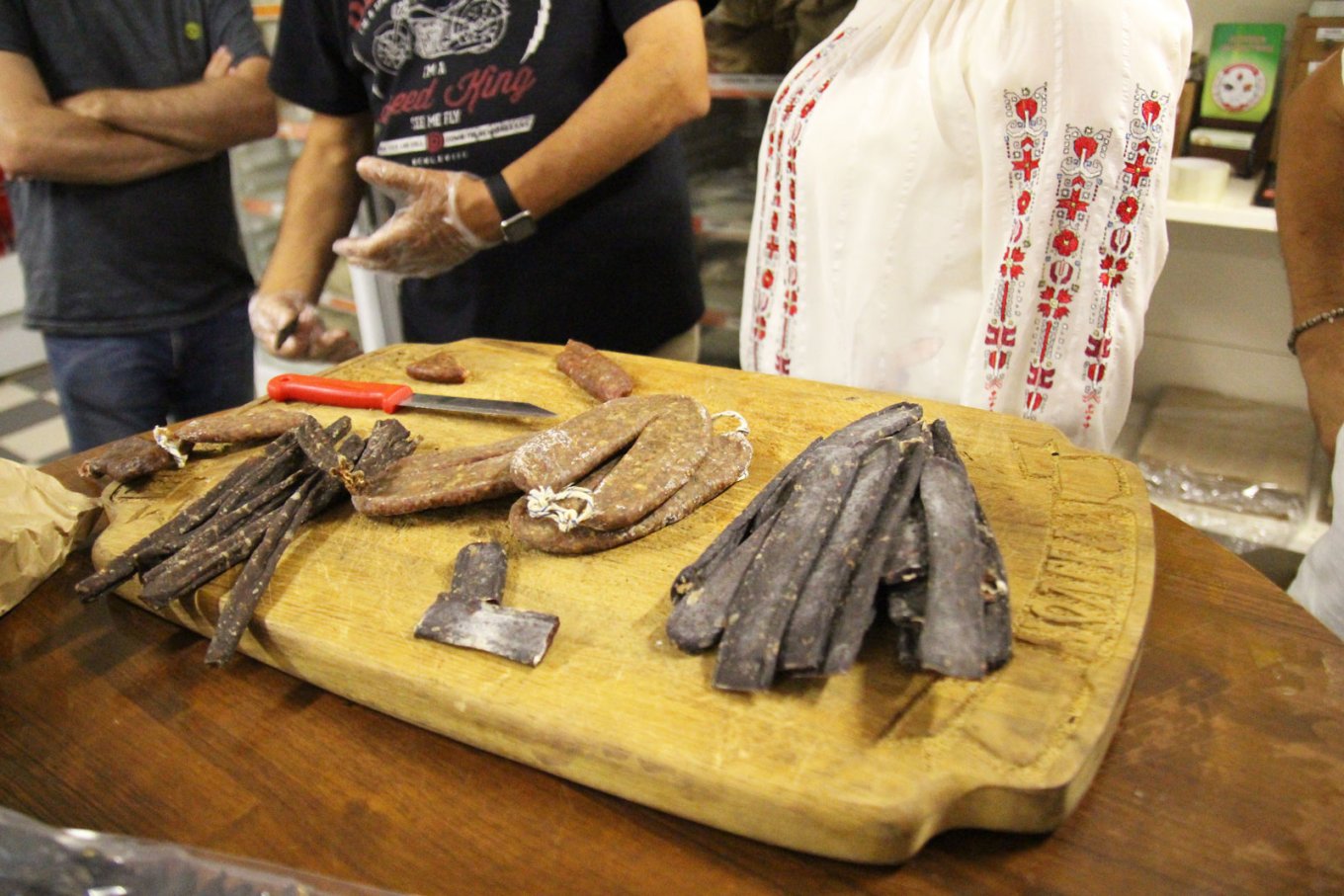
Particular attention is paid to the purchase of raw materials.
“The problem of the specific smell of mutton is solved this way,” Rusev talks. - The animal must not be killed during the rut (sexual activity) and after the disease.
It is very important to remove the lymph nodes, which give the smell of mutton, which disgust many people.
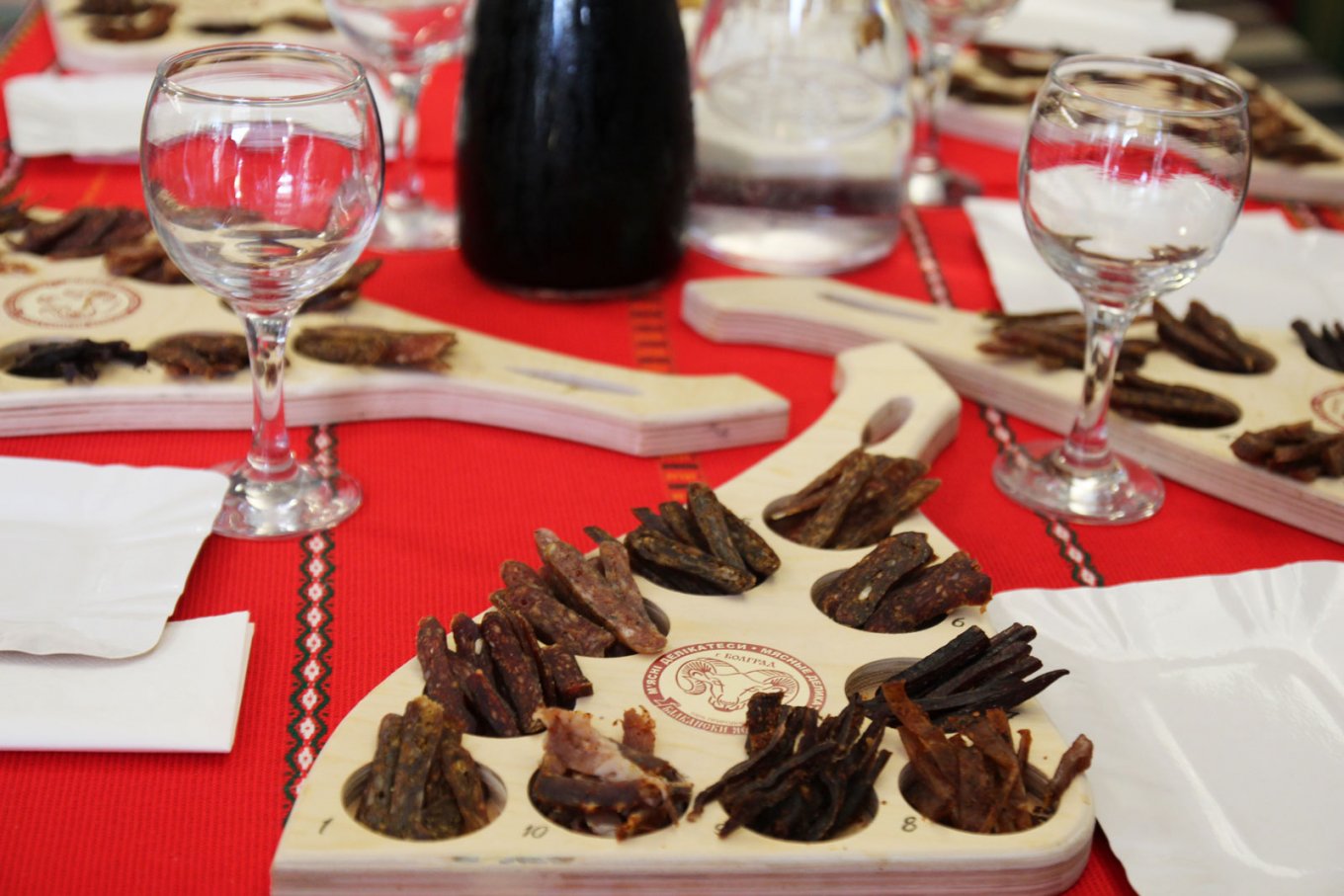
The difference between different jerky dishes is mainly in spices.
- Paprika, hot pepper, chubnitsa (savory) and something else for sujuk, - Sergey Rusev does not give out all secrets. - We add Indian nut (cashew) and garlic to sushenitsa.
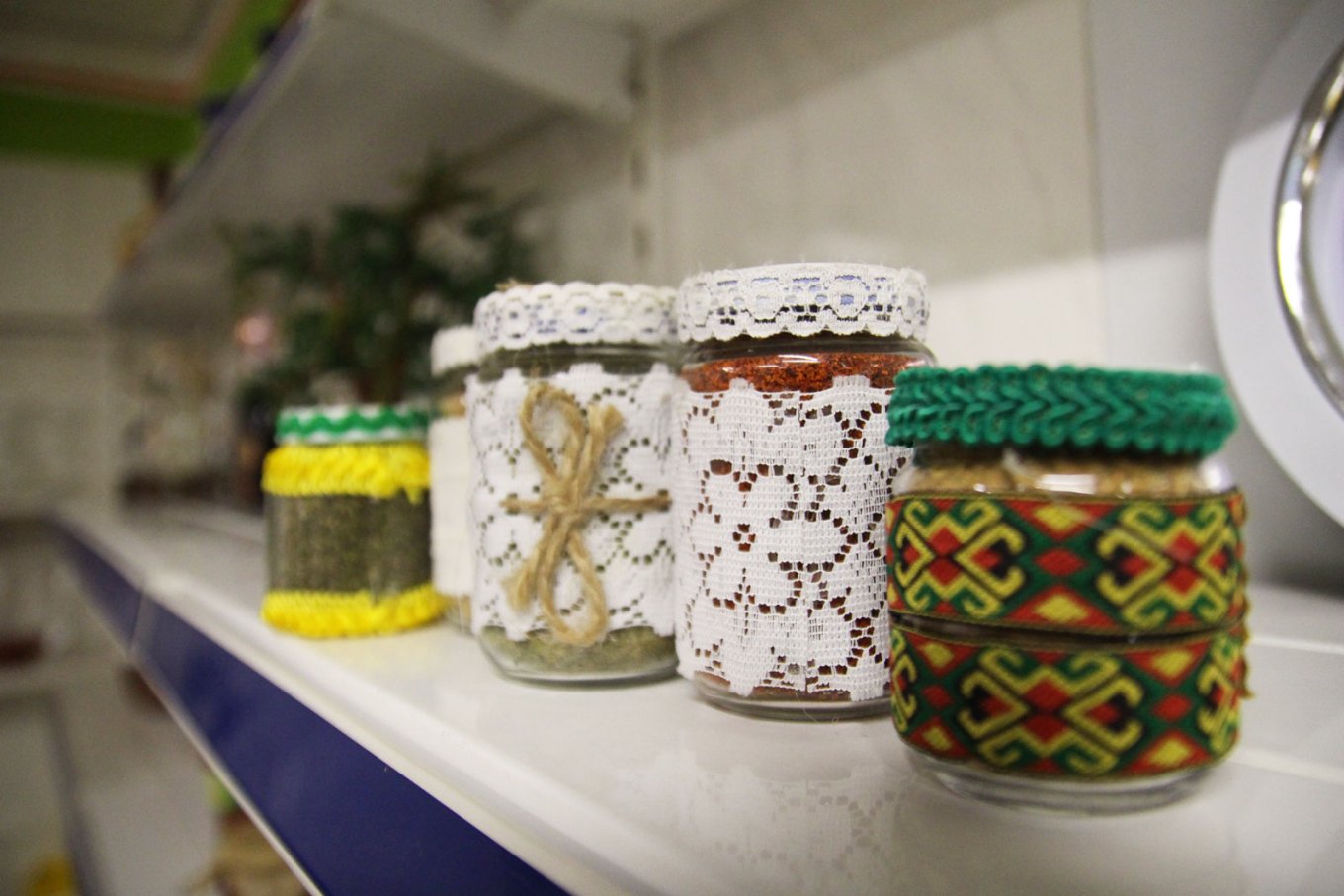
In general, the life of the Bulgarians and their cuisine is impossible to imagine without spices.
Sergei Rusev attempts to restore the forgotten traditions in cooperation with families from different villages that grow certain herbs.
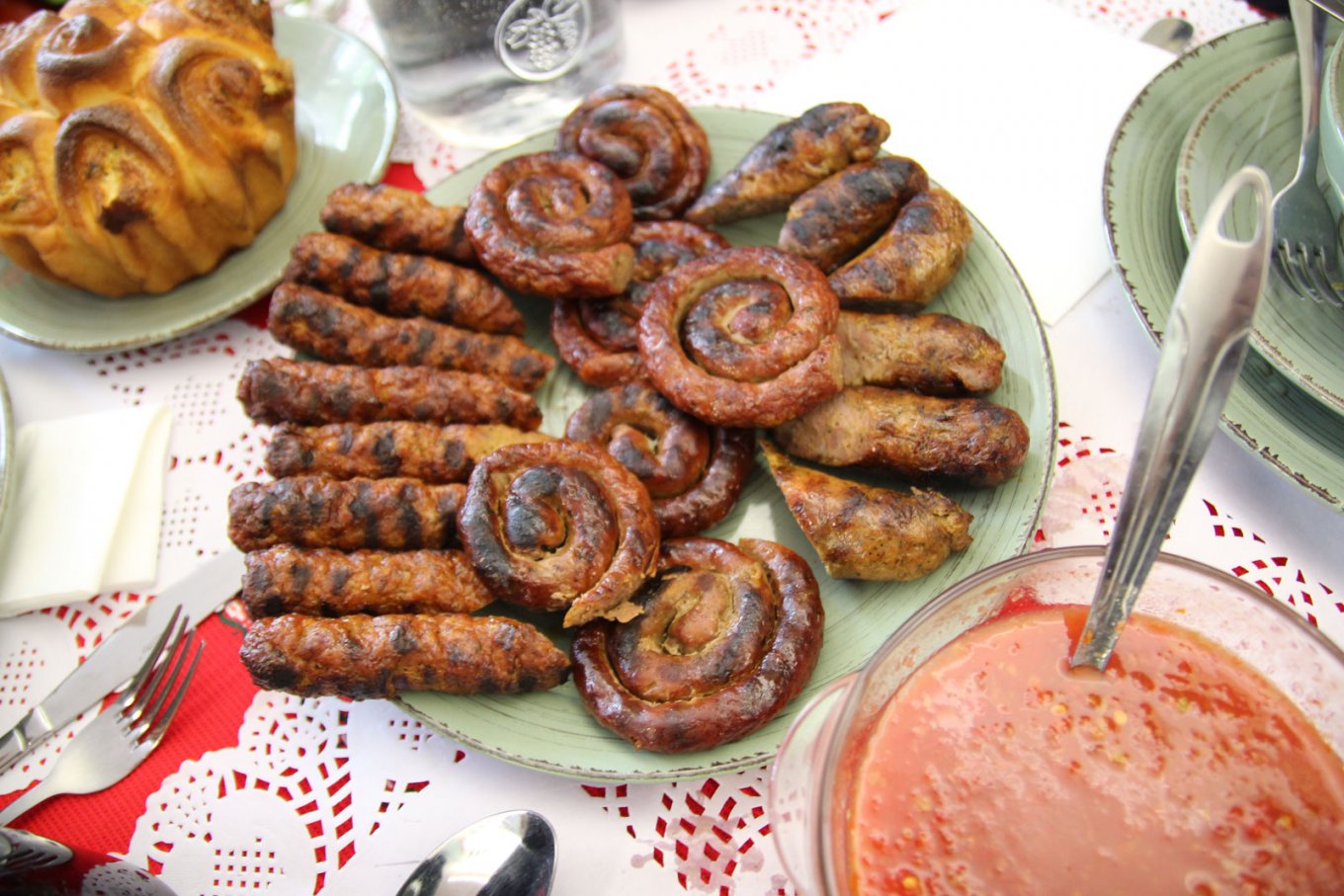
- We took all the spices from Serbia and Bulgaria previously. Now 70% of spices are local. However, cumin, for example, we continue to buy in Bulgaria. It is special there.
A most important ingredient for us is myurdya or merudia (a complex mix of various herbs and seasonings). It's like Chanel №5. If it gets on the clothes, the smell will last a long time.
“Myurdya is a natural flavor enhancer. We were given it in childhood for better appetite,” recalls Rusev.
Krinichnoye. A Wine Valley and a Bright Future
- Bulgarians have 500 songs about wine. Four hundred and ninety-nine about red and one about white, which sounds like this: "White, white, why aren't you a red?!"
The ex-minister of Fuel and Energy Ivan Plachkov tells this joke to everyone who comes to his native village of Krinichnoye, located between Izmail and Bolgrad.
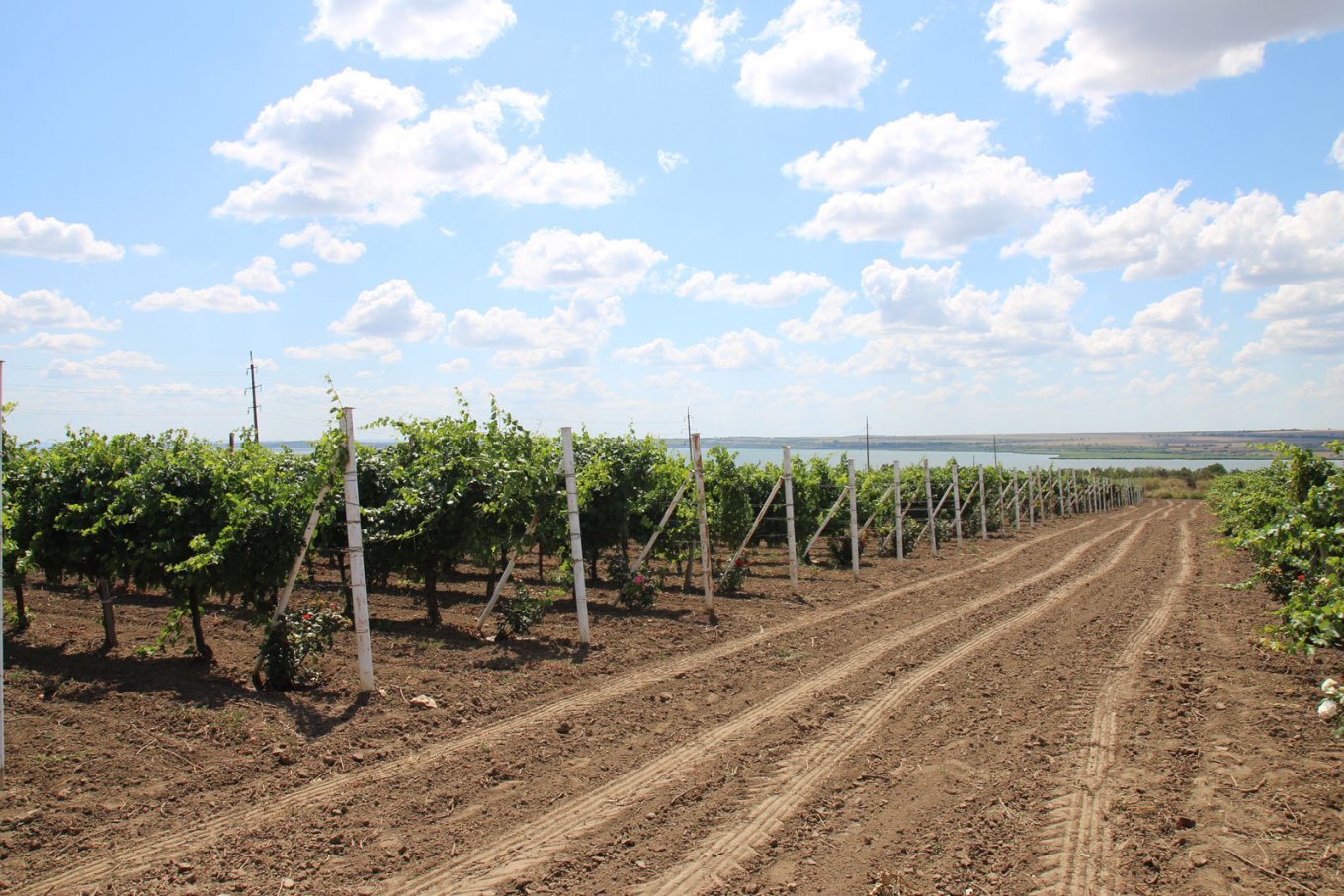
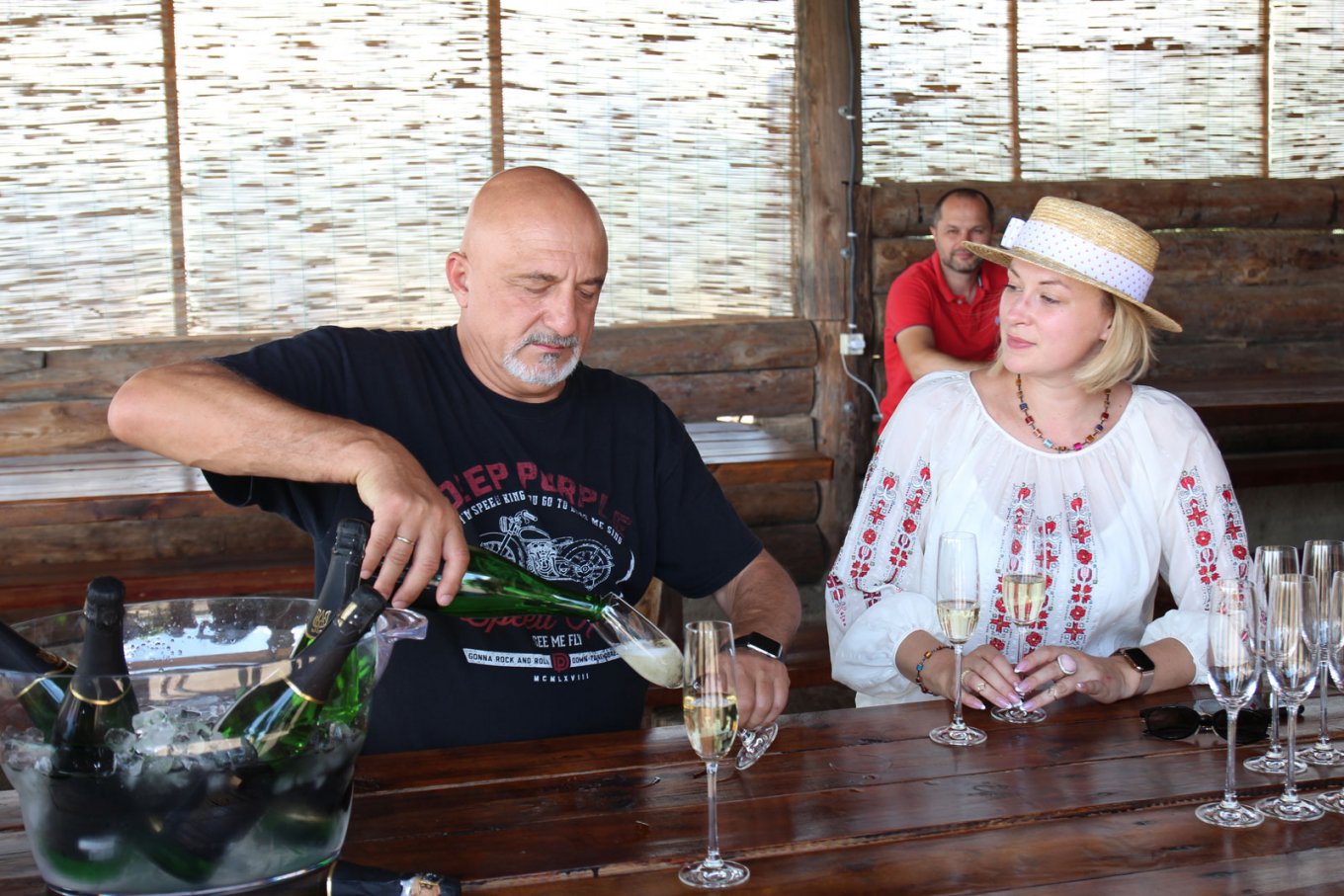
The ex-minister and former governor of Odessa region regards Krinichnoye as one of the best places for wine tasting and acquaintance with Bessarabian cuisine.
Plachkov created the winery Colonist in 2005. Today it produces to 300 thousand bottles of wine a year.
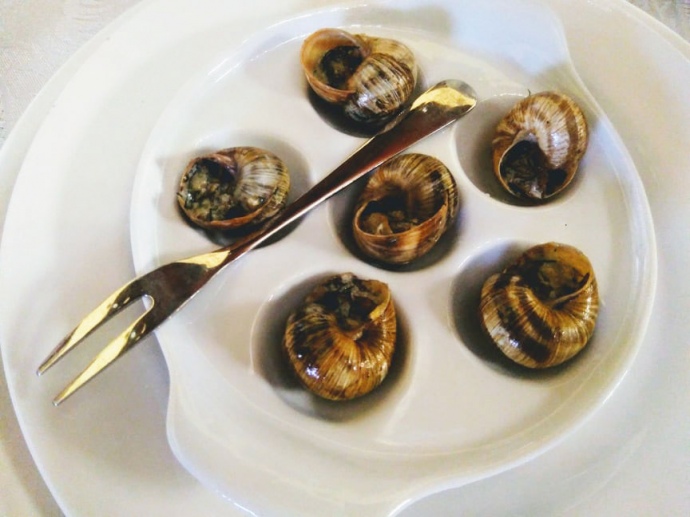
The Colonist wine is being sold mainly in Ukraine. About 10% are exported as “image” parties to show Europeans what Ukrainians are capable of.
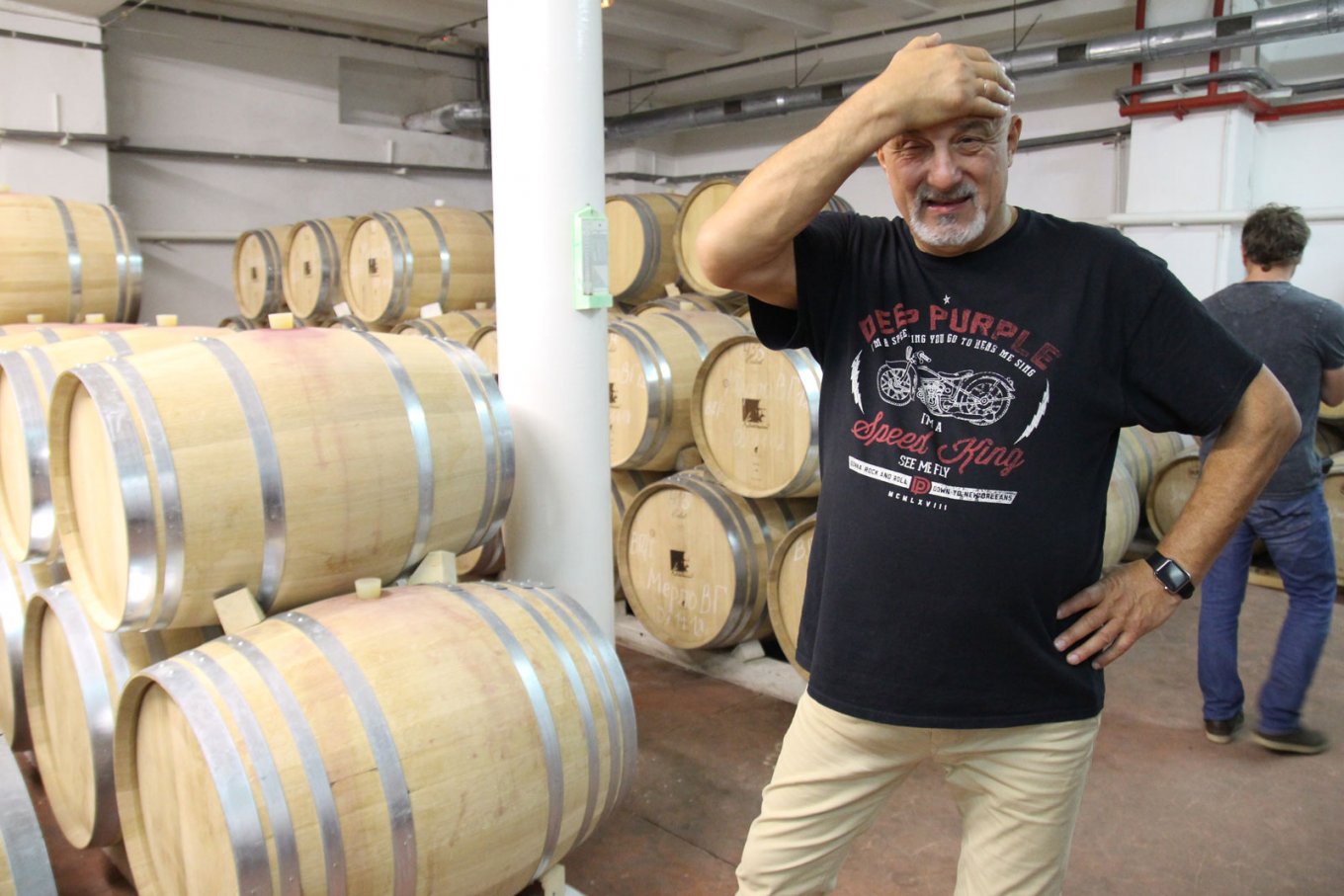
Ivan Plachkov figuratively compares the effect of good wine with a drug.
Plachkov says that viticulture and winemaking are more complex field than nuclear energy.
When asked what the most expensive bottle that he uncorked in life, Plachkov replied: "Up to five thousand euros."
“The main thing is the feeling,” Plachkov shares his experience. “Aged, great wines are tasteless, cloudy, have sediment. There is no bright floral, berry aromas. There is something else is morocco, a briefcase, leather in a car, a saddle of a horse, benzene, boxwood tones.”
This wine affects the brain like the sounds of a brass band, rock band or Mozart.
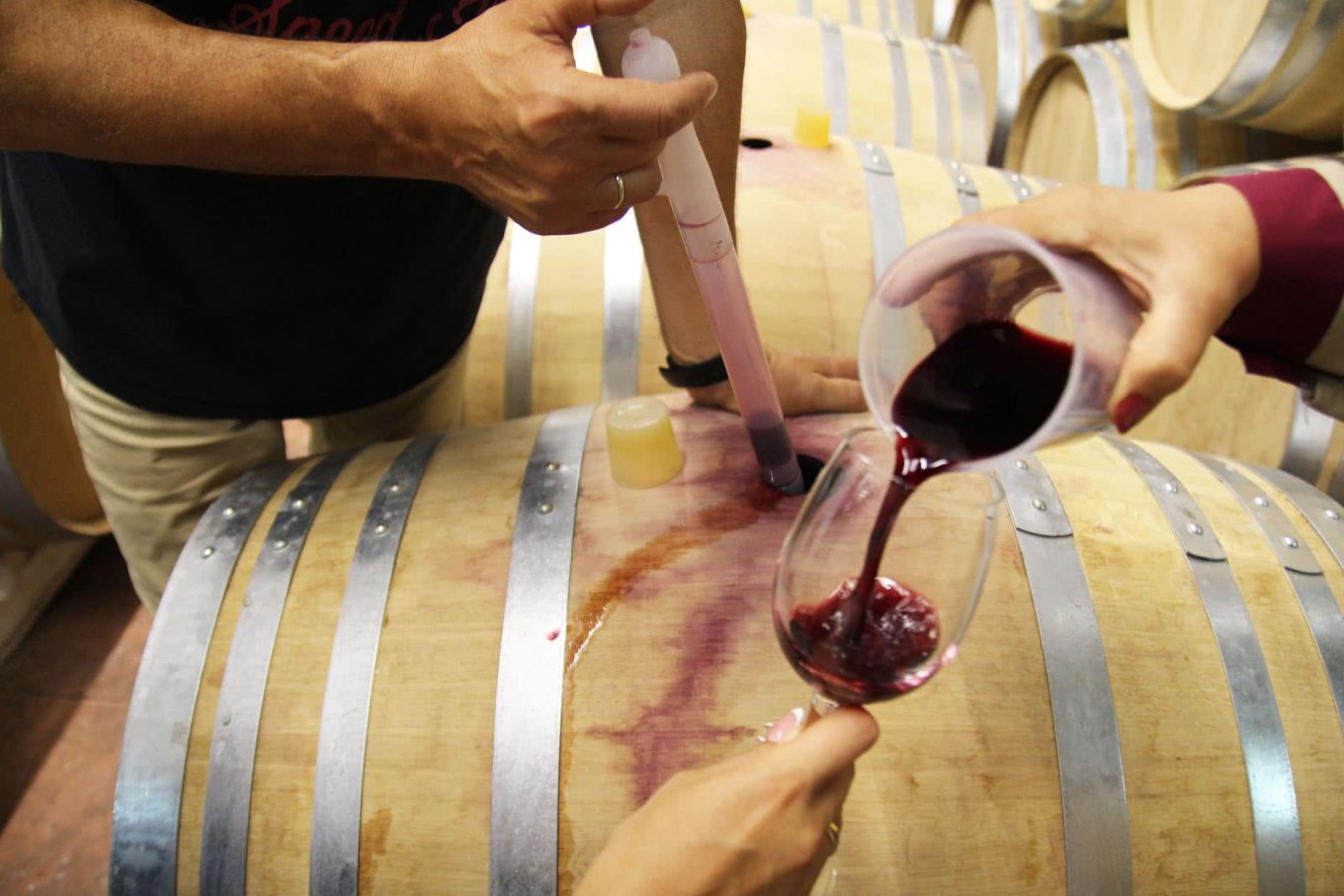
- Why people buy the wine for thousands of euros? He continues. – And just imagine that adult, respectable people gathered to decide whether to give Ukraine 1.5 billion tranche or not.
They tired, sit at some club. They open a bottle of Pétrus. They take a few sips without food, maximum to crispy cheese with crystals. And they have immediately an emotional lift, allowing them to make the right decision.
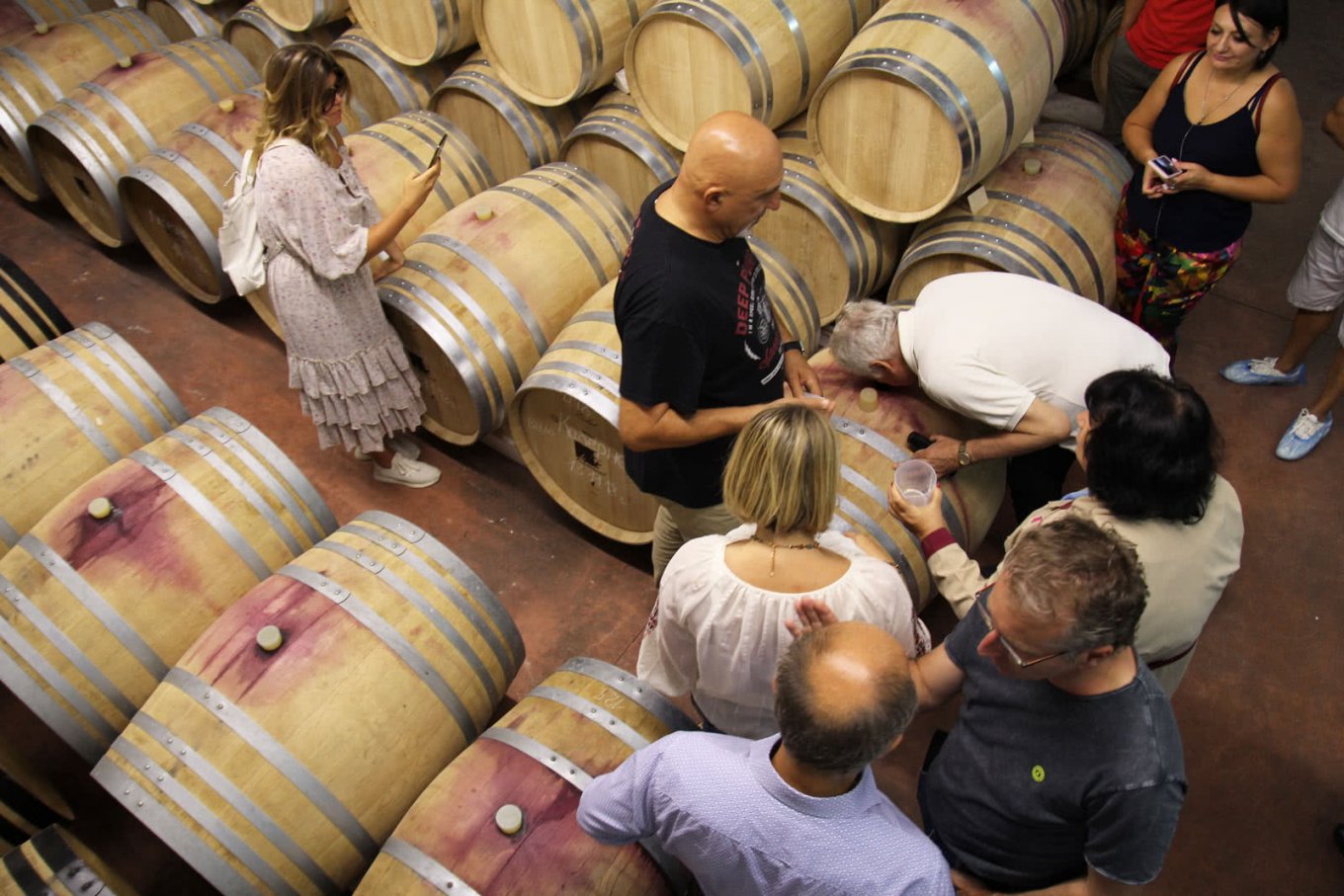
Another comparison to which Plachkov resorts: winemakers are like artists, and a bottle of wine is like a picture.
- Someone will make thousands of paintings, someone five, someone ten. You can buy inexpensive painting for 300 hryvnias on the Andriyivskyy Descent in Kiev. And someone will give away hundreds of thousands or a million at the Sotheby's auction.
There are originals of Shishkin, Aivazovsky and there are reproductions. Both were created by man. However, it has a different value.
The reproductions also have their own consumer who wants to join the beautiful, but he hasn’t money for a real masterpiece.
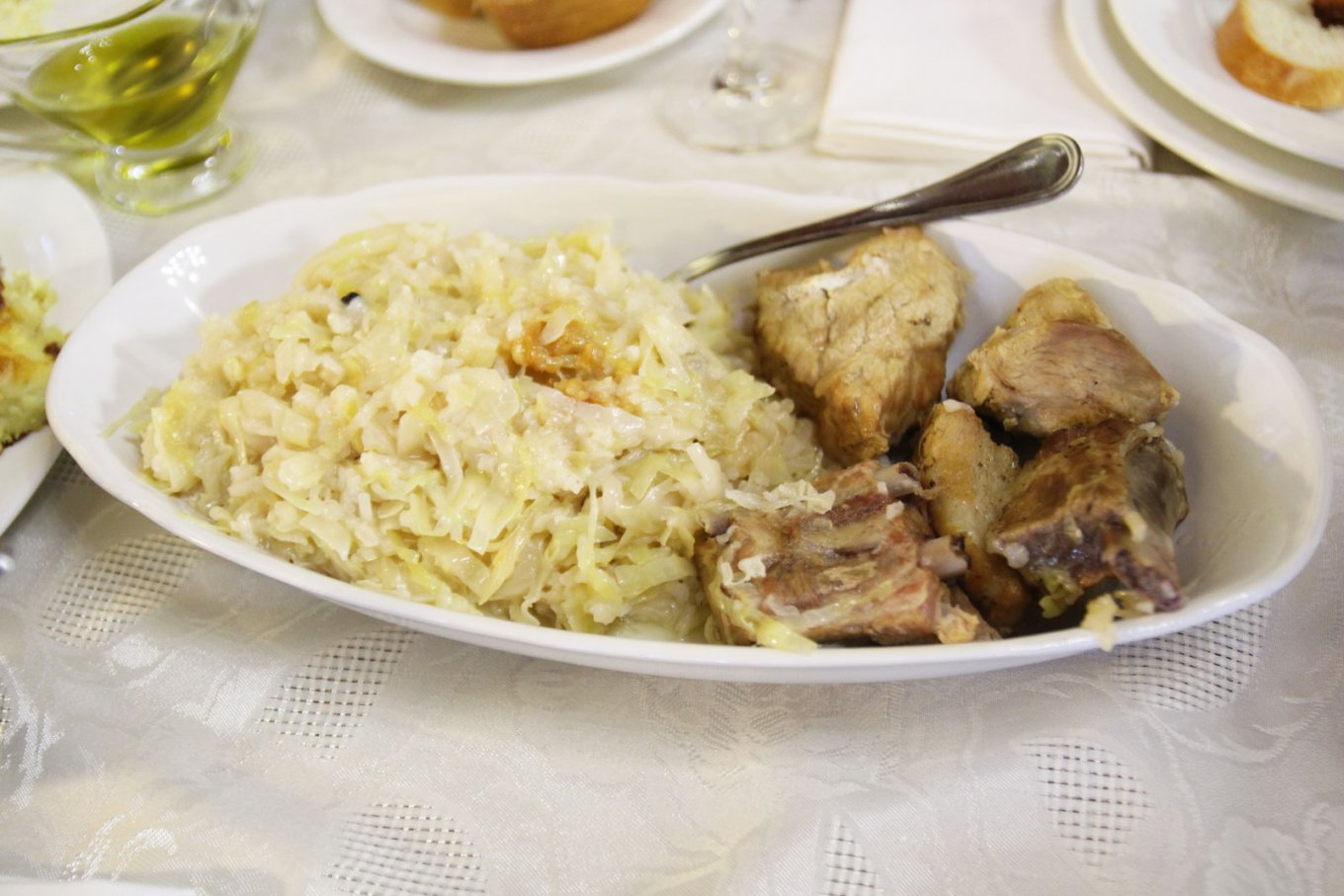
Sitting in the gazebo in the middle of family vineyards in the valley of Yalpuh Lake, Ivan Plachkov exudes optimism.
Bulgarian by nationality, he does not doubt the uniqueness of his native South Bessarabia and its imminent tourist heyday. Judging by his mood a bright future of Ukrainian winemaking is also not far off.
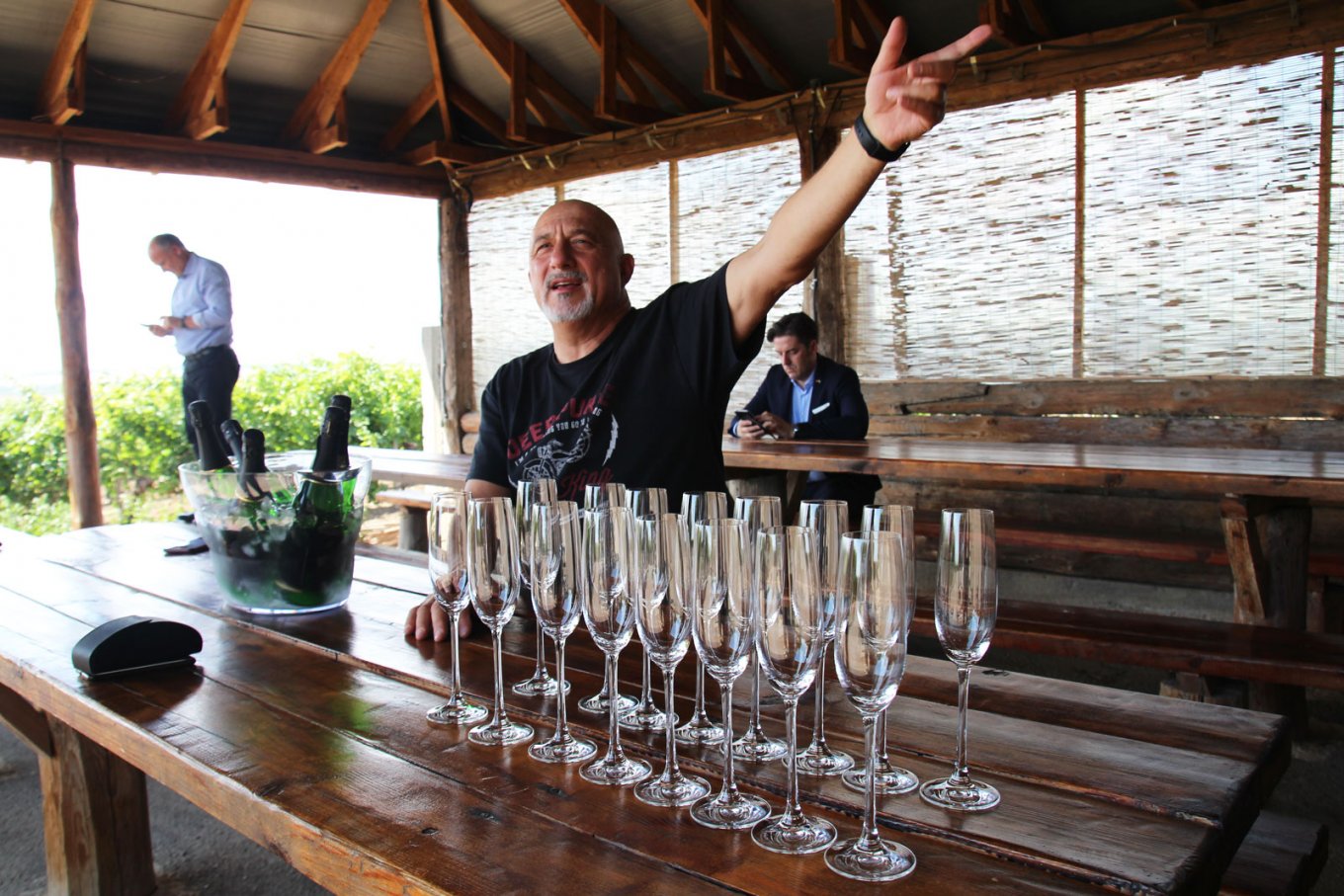
- The culture of wine consumption is growing in Ukraine exponentially. It`s some boom in the last ten years!
Before, when I was a big boss, everyone drank vodka. Then the whiskey from duty free.
Now there is not fashionable to drink vodka. Who is drinking it? What about whiskey? People are tired of it! Everyone drinks wine! - exclaims Plachkov and offers to taste the sparkling wine of his own production.
Read also:
History of Xpark 2002-2023. From the swamp to the largest active park in Europe. Yuriy Zozulya
On the pages of a passport - the heritage of Ukraine, which shares a thousand-year history
What to Bring Home from Ukraine – Looking For Authentic, Yet Offbeat Souvenirs
 How can you support Ukraine?
How can you support Ukraine?